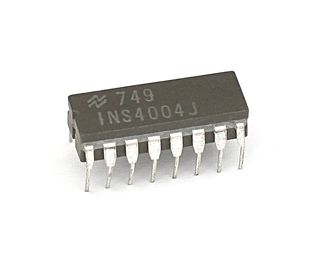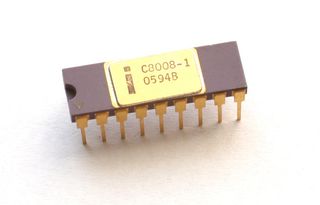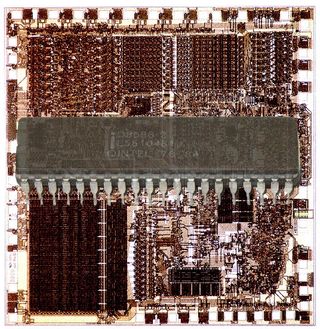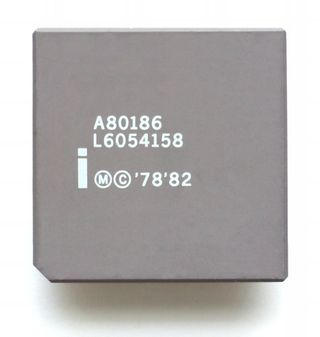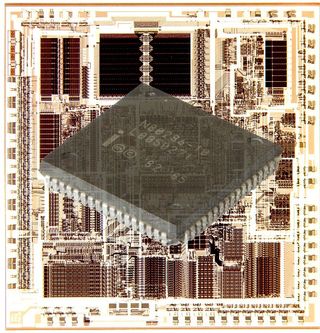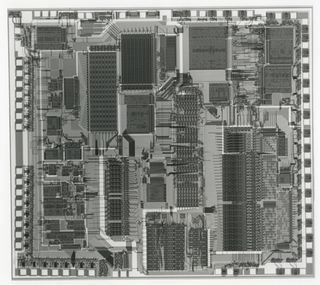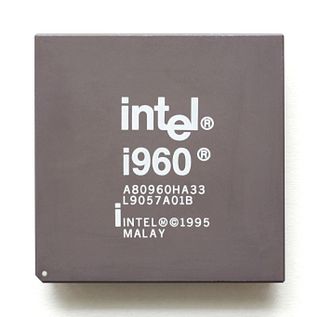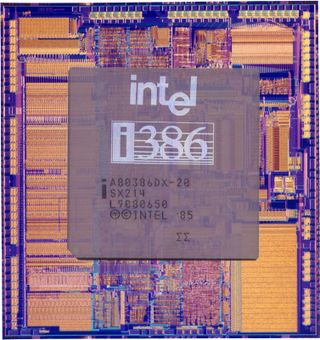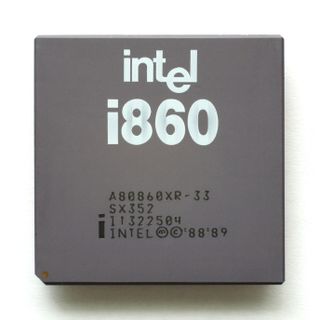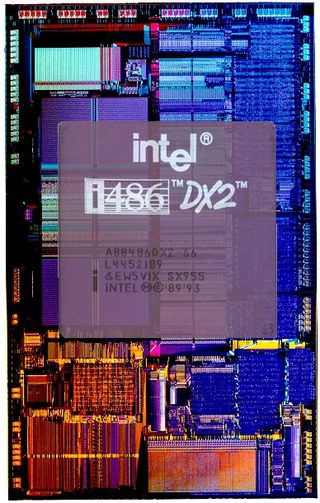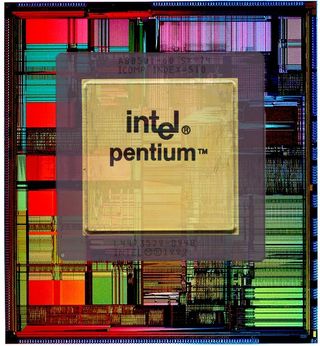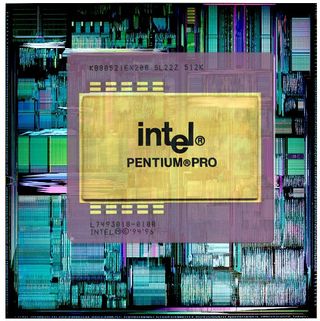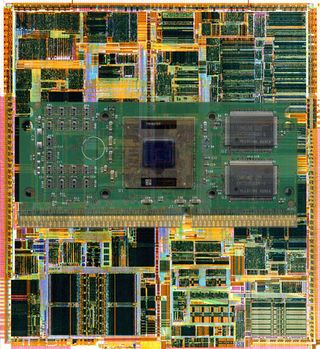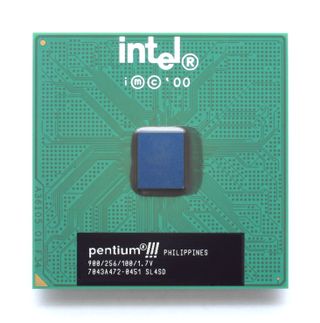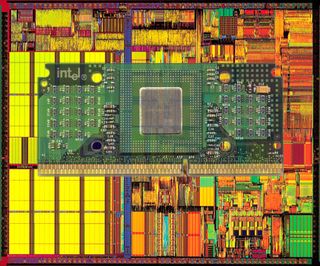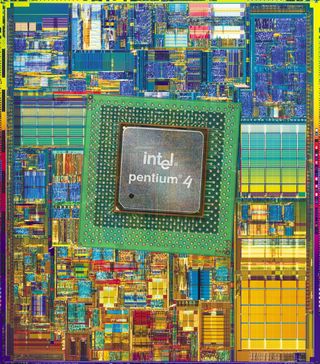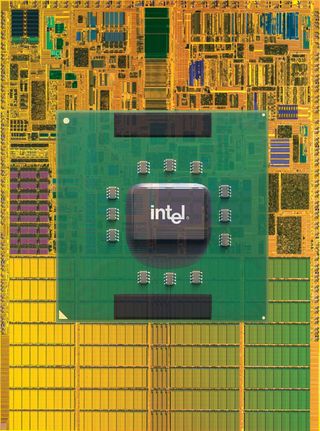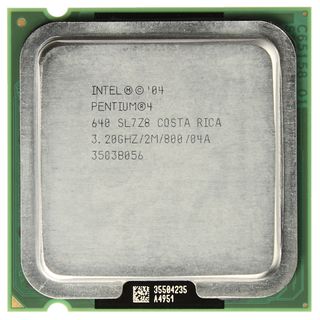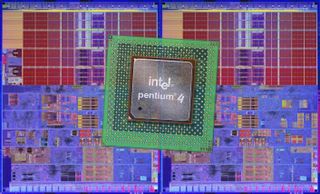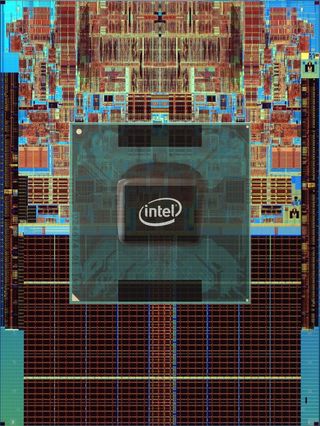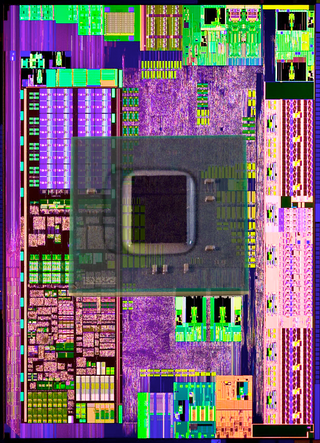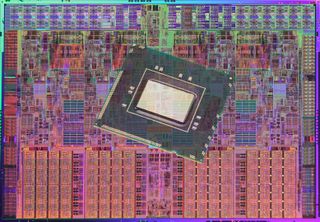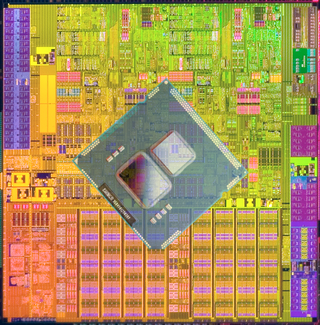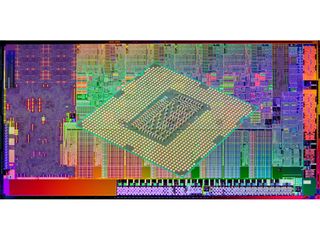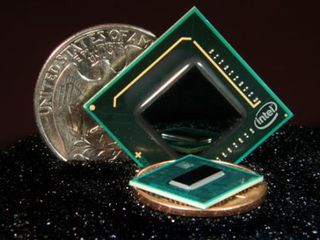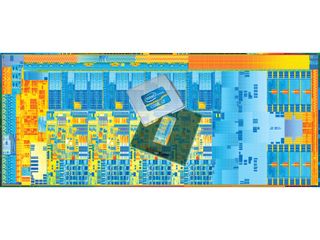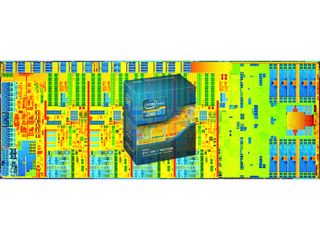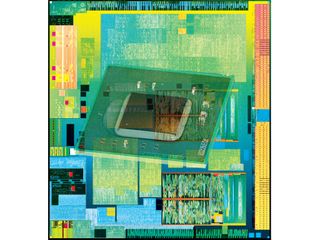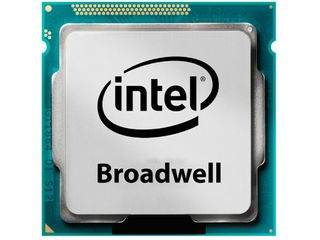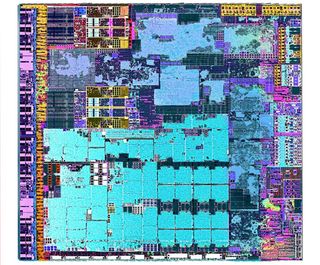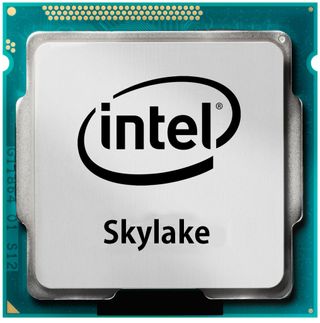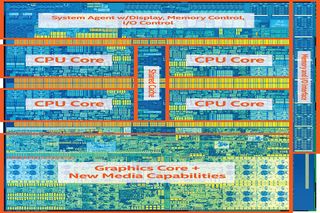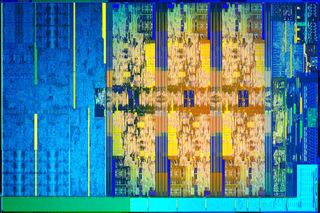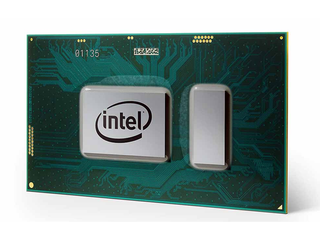注:机翻,未校。
英特尔处理器各代时间线:历史与演变
发表: 2024-01-08
英特尔处理器的发展是一段引人入胜的历史。
1968 年,戈登·摩尔 (Gordon Moore) 前往鲍勃·诺伊斯 (Bob Noyce) 家进行谈话,他们谈论了当前工作的状况以及成立新公司的潜力。
这次命运般的邂逅促成了 1968 年 7 月 18 日英特尔的诞生。该公司将在未来几年改变技术的面貌。
本文将探讨英特尔处理器的历史。 了解使英特尔家喻户晓的突破性发现、标志性设计和持续创新。
让我们开始。
了解 Intel CPU 名称和编号
在继续讨论英特尔处理器的时间表之前,我们首先讨论每个英特尔 CPU 型号的具体含义。
型号名称包含大量数字和字母,可能会造成混淆。
每个英特尔处理器都有以下详细信息:
品牌:指整个产品系列,包括 Core、Pentium、Xeon 和 Celeron。
**品牌修饰符:它描述了该特定品牌下处理器的性能。**品牌修饰剂的价值随着其性能的提高而增加。 例如,i3、i5、i7 和 i9。
**世代指示符:处理器编号的前一位或两位数字代表CPU的世代。**例如,从上面的屏幕截图中,您将看到“Core i5-1035G1”。 “1”代表第一代。
SKU :这是指处理器编号的最后三位数字。 SKU 越高,意味着处理器包含的功能越多。 Core i5-1035G1 的 SKU 是“035”。
产品线后缀: “Core i5-1035G1”的最后一个字母是“G1”。 这是CPU的特性。 Intel Core的一些产品线后缀包括“H”代表高性能显卡、“K”代表超频解锁、“C”代表带有高端显卡的桌面处理器等。
每个英特尔处理器都有以下详细信息:
品牌:指整个产品系列,包括 Core、Pentium、Xeon 和 Celeron。
品牌修饰符:它描述了该特定品牌下处理器的性能。 品牌修饰剂的价值随着其性能的提高而增加。 例如,i3、i5、i7 和 i9。
世代指示符:处理器编号的前一位或两位数字代表CPU的世代。 例如,从上面的屏幕截图中,您将看到“Core i5-1035G1”。 “1”代表第一代。
SKU :这是指处理器编号的最后三位数字。 SKU 越高,意味着处理器包含的功能越多。 Core i5-1035G1 的 SKU 是“035”。
产品线后缀: “Core i5-1035G1”的最后一个字母是“G1”。 这是CPU的特性。 Intel Core的一些产品线后缀包括“H”代表高性能显卡、“K”代表超频解锁、“C”代表带有高端显卡的桌面处理器等。
早期的英特尔处理器
英特尔开发的处理器的发展在各代处理器中都有显着改进。 每一代之间的关键变化是架构。
随着时间的推移,英特尔改进了其超频、缓存和 RAM 支持。 较新的 CPU 实现了更高的时钟速度和更高的能效。
现在让我们来看看英特尔处理器的时间表和其他相关信息。
1971-81 年:4004、8008 和 8800
英特尔处理器在 20 世纪 70 年代经历了大规模创新,诞生了 4004、8008 和 8800。
这些处理器极大地影响了未来计算技术的发展。
英特尔4004
当英特尔发布 4004 时,它将所有 CPU 操作组合到单个芯片上,从而改变了市场。 它是第一个商业化销售的处理器。
Intel 4004有 2,300 个晶体管,处理时钟速度在 108 至 740 kHz 之间。 这导致性能达到每秒 7 万条指令 (MIPS)。
笔记:
时钟速度是指计算机的CPU(也称为计算机的大脑)执行操作的速度。它测量 CPU 一秒钟内完成的周期数。 这个速度至关重要,因为它影响计算机处理信息的速度。
时钟速度以赫兹 (Hz) 为单位,典型前缀为千兆赫 (GHz) 和兆赫 (MHz)。每秒一百万个周期等于一兆赫,而每秒十亿个周期等于一千兆赫。 更快的CPU主频通常意味着计算机可以快速处理信息。
英特尔8008
8008 继 4004 之后,拥有 3,500 个晶体管,时钟速度为 0.5 至 0.8 MHz,主要用于德州仪器 (Texas Instruments) 742 计算机。 它于 1972 年发布。
英特尔8080
Intel 于 1974 年发布了 8080,拥有 4,500 个晶体管,时钟速度高达 2 MHz。 8080被用于波音公司制造的AGM-86巡航导弹。它还因在 Altair 8800 微型计算机套件中的使用而闻名。
1978-82:iAPX 86 (8086)、8088 和 80186(16 位)
按代列出的其他英特尔处理器包括 iAPX 86 (8086)、8088 和 80186(16 位)。
1978 年至 1982 年间 iAPX 86 (8086) 及其型号的发布是英特尔处理器发展的一个重要转折点。
1978 年 iAPX 86 (8086) 推出时,英特尔首款 16 位 CPU 上市销售。 它有 29,000 个晶体管,时钟速度为 5 至 10 MHz。
该芯片帮助建立了经久不衰的 x86 架构,从而增强了英特尔的市场主导地位。
1978年,Intel同时推出了8088,与8086几乎相同,但具有8位内部总线。
8088 在第一台 IBM PC 中发挥了至关重要的作用,这是个人计算历史的转折点。
| 处理器 | 晶体管 | 应用领域 | 时钟速度(MHz) |
|---|---|---|---|
| iAPX 86 (8086) | 29,000 | IBM PS/2、计算机 | 5-10 |
| 80186 | 2,000 | 嵌入式系统 | 超过 1 |
| 8088 | 29,000 | IBM个人电脑 | 5-10 |
1981:iAPX 432
iAPX 432 是不太成功的英特尔处理器系列之一。 432 于 1981 年首次亮相,是 Intel 首次尝试32位设计。
它具有极其复杂的架构,具有集成的内存管理和多任务处理功能。
尽管很复杂,但该处理器的生产成本使其不受欢迎,并限制了其商业吸引力,因为它比新的 80286 架构慢。
432 项目最初是为了取代 8086 系列。 它于 1982 年结束,但它帮助英特尔完善和推进了其 CPU 设计。
1982年:80286
Intel 80286发布时,改进了内存管理并具有强大的安全功能。
到 1991 年,它的时钟速度高达 25 MHz,性能超过 4 MIPS。
该 CPU 拥有 134,000 个晶体管,制造规模为 1,500 nm,广泛应用于 IBM-PC AT 和 AT PC 克隆机中。它是英特尔处理器发展过程中最经济的芯片之一。
你可知道…
半导体技术和微电子学中用于描述元件尺寸的测量单位已从微米 (μm) 变为纳米 (nm)。
这种变化反映了制造工艺的不断进步,使得生产越来越复杂和越来越小的部件成为可能。
例如,在讨论集成电路和处理器时,芯片上晶体管和其他功能的尺寸通常以纳米为单位进行测量。
从微米到纳米的变化使得开发密集且高效的电子元件成为可能。这有助于创建更小、更强大的设备。
80286 至今仍被人们铭记为英特尔处理器历史上的一个转折点,因为它的性能比上一代有了大幅提升。
2007 年,英特尔表示,新款 Atom CPU 是英特尔各代处理器列表中唯一一款能够在25年后与80286的成本效益相媲美的处理器。
这使得它成为希望在不花太多钱的情况下升级计算机系统的个人和公司的最佳选择。
| 处理器 | 时钟速度 | 晶体管数量 | 性能(MIPS) |
|---|---|---|---|
| 80286 | 6-25兆赫 | 134,000 | 4+ |
| 80186 | 6-10兆赫 | 55,000 | 1+ |
| 8088 | 5-10兆赫 | 29,000 | 1+ |
| 8086 | 5-10兆赫 | 29,000 | 1+ |
1985-94:386 和 376
386DX CPU 于 1985 年发布,拥有 275,000 个晶体管 (1,500 nm),时钟速率范围为 16 至 33 MHz,最高可达 11.4 MIPS。
*笔记:*
MIPS(每秒百万条指令)衡量处理器的速度或性能。它显示计算机处理器一秒钟可以处理多少机器级指令。
较高的 MIPS 分数通常意味着更好的性能,但请记住,MIPS 本身并不能全面反映处理器的功能。整体性能也很大程度上受到其他因素的影响,包括时钟速度、架构和指令类型。
这是英特尔处理器历史上32位时代的开始。 386SX 于 1988 年发布。
该处理器采用 1,000 nm 设计和 16 位总线,适用于移动和经济实惠的桌面系统。 在 80387 发布之前,两者都使用 80287,并且都没有数学协处理器。
Intel 的 386SL (1990) 是该公司首款配备片上高速缓存、控制器和 855,000 个晶体管的笔记本处理器。
英特尔提升笔记本电脑市场份额
英特尔增加了其在笔记本电脑领域的市场份额。 该处理器专为移动设备设计,专注于低功耗运行以延长电池寿命。
它的时钟速度在 20 到 25 MHz 之间。 用于嵌入式系统的 376/386 系列由 386EX (1994) 和 376 (1989) 组成。
由于嵌入式和航空航天应用的需求,英特尔继续构建 80386 系列直到 2007 年 9 月,尽管消费计算机不再需要它。
| 处理器 | 米普斯 | 时钟速度(MHz) | 晶体管 |
|---|---|---|---|
| 386SX | 8.7 | 16-33 | 275,000-120万 |
| 386DX | 11.4 | 16-33 | “ |
| 386SL | 5.6 | 20-25日 | “ |
| 386EX | 7.8 | 16-33 | “ |
在处理器的发展过程中,386SL 为便携式计算铺平了道路。
1989 年:486 和 i860
Intel于1989年推出的486 CPU是Intel处理器历史上的一次重大改进。
该微处理器成为英特尔最受欢迎和最成功的芯片,并以 70.7 MIPS 和 25 至 100 MHz 的时钟速度改变了个人计算。
Intel同时发布了i860处理器,进军 精简指令集计算(RISC)处理器行业。
然而,i860 及其替代品 i960 并没有取得成功,即使具有快速处理基本命令的优势。
这使得Intel将注意力转向广泛使用的x86架构。
笔记:
X86架构是基于Intel 8086 CPU的计算机处理架构。在这些设计中,“32 位”和“64 位”一词指的是数据总线的宽度,它影响处理器一次可以处理的数据量。
在 32 位架构中,处理器可以处理 32 位块中的数据。这意味着它一次最多可以处理 32 位数据。它通常是为较旧的硬件和软件设计的。
在 64 位架构中,CPU 可以处理 64 位块中的数据。这意味着可以同时处理更多数据,并且内存地址可以更大。
奔腾的黎明及以后
Intel于1993年推出了Pentium,它成为Intel处理器历史上的重要组成部分。
据报道,英特尔因商标保护而改名为Pentium,以对抗AMD,AMD将其处理器命名为486。
然而,奔腾处理器以其强大的性能和先进的多媒体功能改变了计算行业。
它为个人计算设立了新标准,并为下一代英特尔处理器铺平了道路。
以下是英特尔奔腾处理器的时间表:
1993:奔腾(P5、i586)
P5 Pentium 于 1993 年发布,频率为 60 MHz,1996 年达到 200 MHz (P54CS)。第一个 800 nm 设计中包含 310 万个晶体管。
在 1996 年版本中,这个数字增加到 330 万,尺寸更小,为 350 nm。
当 P55C(多媒体扩展)于 1997 年发布时,处理器的架构得到了改进,包括 450 万个晶体管和 233 MHz 时钟速度。
Pentium MMX 移动型号于 1999 年问世,最高速度为 300 MHz。
在英特尔处理器的发展历程中,他们通过在每一代处理器中添加新功能并提高时钟速度来不断改进奔腾品牌。
1997 年,随着 Pentium MMX 的发布,该公司迎来了一个转折点。 这增加了多媒体处理的专门指令并提高了多媒体性能。
这一进步特别改进了图像编辑,确保了流畅的视频播放,并提高了游戏的身临其境的质量。
1994-99:Intel Pentium III 处理器及其之前的问题
1994 年,林奇堡学院的一位教授发现奔腾处理器存在问题,导致英特尔遭受重大挫折。
Pentium FDIV 错误导致特定操作的除法结果不准确,这导致了相当多的批评并损害了英特尔的声誉。
这是英特尔处理器历史上的重大挫折之一。 不过,该公司很快解决了问题,并向受影响的用户提供免费更换。
五年后,Intel于1999年发布了Pentium III CPU。这次发布有一个CPU序列号(PSN)用于唯一标识。
这一识别引起了消费者对可能非法跟踪的隐私担忧。 由于这些担忧,英特尔停止在其处理器中嵌入 PSN 功能。
1995:奔腾 Pro(P6、i686)
大多数人误解了 Pentium Pro,但它并不是要取代 Pentium 5。
它应该作为奔腾 II 至强的前身,以工作站和服务器工作负载为中心。
Pentium Pro 内置 350 nm 工艺,包含 550 万个晶体管和多种型号,速度范围为 150 至 200 MHz。
其独特的设计允许乱序执行,其 36 位地址总线支持高达 64 GB 的内存。
它因突破 ASCI Red 超级计算机上 1 teraflop 的性能障碍而受到欢迎。
1997 年:奔腾 II 和奔腾 II 至强
Pentium II CPU基于第六代P6架构,主要面向消费者设计。
它突破了传统的插座设备,引入了类似于卡盒的插槽模块。
它解决了第一个 P6 版本中的问题,并显着改进了 750 万个晶体管(比 P6 多了 200 万个)的 16 位执行能力。
Pentium II 保留了 Pentium II 前身 Pentium 的 MMX 指令集。 Pentium II 首次发布时采用 350 nm Klamath 内核(233 和 266 MHz)。
然而,在 1998 年,它升级为 250 nm Deschutes 核心,时钟速度可以达到 450 MHz。 它还为 Pentium Pro 升级提供了 Pentium II Overdrive。
250 nm/180 nm Dixon 和 250 nm Tonga 内核均用于移动 Pentium II 处理器。
1998:赛扬
尽管赛扬使用现代处理技术,但它们通常有显着的降级,例如较少的高速缓存,并且仅适用于简单的 PC 应用程序。
得益于赛扬,英特尔能够在入门级 PC 市场展开竞争。 台式机的频率范围为 266 至 300 MHz,移动设备的频率范围高达 500 MHz。
因此,最初的赛扬系列在台式电脑上使用 250 nm Covington 核心,在笔记本电脑上使用 250 nm Mendocino 核心(1900 万个晶体管,包括 L2 片内缓存)。
现代赛扬不断更新,其架构源自Sandy Bridge。
1999 年:奔腾 III 和奔腾 III 至强
在英特尔处理器的发展过程中,该公司加入了 AMD 的千兆赫兹竞赛,并于 1999 年发布了 Pentium III,应对了 Transmeta 的低功耗挑战。
首先,它有一个 250 nm Katmai 核心。 之后,它又拥有 180 nm Coppermine 和 Coppermine T 核心以及 130 nm Tualatin 核心。
由于集成了二级缓存,卡特迈的晶体管数量从 950 万个增加到 2810 万个。 对于 Tualatin,时钟频率从 450 MHz 到 1,400 MHz 不等。
英特尔的第一个千兆赫版本被匆忙推出,这导致了召回和重新发布。 英特尔因此受到批评。
SpeedStep 能够实现 CPU 时钟速度缩放,于 2000 年通过 Mobile Pentium III 首次向消费者展示。
它是在 Transmeta Crusoe CPU 推出后不久推出的,引发了竞争压力的传言。
与 Pentium 名称相关的 Pentium III Xeon 于 1999 年与 Tanner 核心一起首次亮相。
你可知道…
在 20 世纪 90 年代末和 2000 年代初,AMD 和英特尔进行了一场名为“千兆赫竞赛”的竞赛,其重点是提高 CPU 时钟速度。
尽管人们认为更高的千兆赫值对应于更高的性能,但这种方法也有缺点,包括产生更多的功率和热量。
*最终,两家公司将重点转向引入更多内核、提高效率并改进整体处理器架构。*如今的 CPU 性能评估采用了更全面的方法,考虑的因素不仅仅是时钟速度。
2000 年:奔腾 4
2000 年,Pentium 4 标志着英特尔处理器发展史上的一个关键转变。 它采用 180 nm Willamette 核心(4200 万个晶体管)推出。
Netburst 架构规划了时钟速度可扩展性,预计到 2010 年达到 20 GHz。但是,随着时钟速度的提高,电流泄漏和功耗迅速增加,因此出现了限制。
从 1.3 GHz 开始,2005 年使用 90 nm Prescott 核心(1.25 亿个晶体管)达到了 3.8 GHz。
2005 年,Pentium 4 系列变得更加复杂,推出了 Mobile Pentium 4-M、Pentium 4E HT(超线程)和 Pentium 4F(65 nm Cedar Mill 内核)等型号。
原本打算取代 Pentium 4 的 Tejas 被取消,转而采用 Core 架构。 这导致处理器的发展发生了以效率为中心的重大转变。
2001:至强
Netburst 架构采用 180 nm Foster 内核和 1.4 至 2 GHz 的时钟速度,用于第一款不带 Pentium 品牌的 Xeon。
Netburst 架构一直持续到 2006 年,当时推出了具有不同核心数量的完整 Xeon 处理器产品组合,包括 Nocona、Irwindale、Cranford、Potomac、Paxville、Dempsey 和 Tulsa。
为了应对功耗问题,英特尔重新设计了其架构,完成了配备双核 Dempsey CPU 的 Netburst Xeons。
现代 Xeon 基于 32 nm Sandy Bridge 和 Sandy Bridge-EP 架构,拥有多达 10 个内核、3.46 GHz 时钟速率和多达 26 亿个晶体管。
2001:安腾
安腾是按照 i860 和 iAPX 432 原理建模的,并且长期被误解。
尽管早期受到质疑,但它得到了强大支持者的支持,并且继续使用。
当安腾于 2001 年作为英特尔首款 64 位 CPU 推出时,其 32 位性能限制引起了批评。
180 nm Merced 内核首次亮相,拥有 3.2 亿个晶体管,时钟频率为 733 MHz 和 800 MHz。
安腾 2 于 2002 年首次发布,直到 2010 年才进行不定期更新。
其核心包括 McKinley、Madison、Deerfield、Hondo、Fanwood、Montecito、Montvale 和 Tukwila,拥有超过 20 亿个晶体管和 24 MB 的大型片内缓存。
2002:超线程
2002年,英特尔通过引入超线程技术,在桌面CPU的处理器演进上取得了突破。
超线程技术首先在 Xeon 和 Pentium 4 CPU 中引入,它允许两个线程同时运行,可以将速度提高多达 30%。
这项技术继续出现在后来的英特尔处理器中,例如奔腾 D、凌动、酷睿 i 系列和安腾 CPU,它有助于增强处理能力。
笔记:
*超线程技术 (HTT) 是一种处理器技术,可通过在单个内核上同时运行多个线程来提高性能。它通过将核心划分为虚拟核心来允许指令并行执行。
这提高了整体效率和资源利用率,并使 CPU 能够同时处理大量任务。AMD 将其实现称为同步多线程 (SMT),而英特尔将其称为超线程技术 (HTT)。
2003:奔腾M
凭借功耗更低的130纳米Banias核心,英特尔于2003年发布了面向移动计算的Pentium M 700系列。
由于 Mooly Eden 以色列设计团队的领导,该处理器强调电源效率而不是时钟速度。
Banias 的 TDP 降低至 24.5 瓦,时钟速度范围为 900 MHz 至 1.7 GHz,比 Pentium 4 Mobile 的 88 瓦大幅降低。
90 nm Dothan 版本拥有 1.4 亿个晶体管,时钟频率高达 2.13 GHz,TDP 进一步降低至 21 瓦。
Dothan被取代后,Yonah在2006年发展成为Core Duo和Core Solo,以类似于4004、8086和386的方式影响Intel的未来。
2005:奔腾D
Pentium D 是 2005 年发布的英特尔处理器第一代双核 CPU 之一。
Pentium D 800 系列的第一版使用了 Smithfield 核心,这是两个 Northwood 核心的 90 nm 版本,同时保留了 Netburst 架构。
后来,它成为具有两个 Cedar Mill 核心的 65 nm Presler。
Extreme Edition 的消费级台式机 CPU 功耗达到创纪录的 130 瓦(服务器处理器达到 170 瓦)。
它将最大时钟速度限制为 3.73 MHz。 普雷斯科特拥有 3.76 亿个晶体管,而史密斯菲尔德拥有 2.3 亿个晶体管。
笔记:
*双核处理器是一种在单个芯片上具有两个独立处理单元的 CPU。*同时执行指令的能力提高了系统的整体性能和多任务处理能力。
2006:Core 2 双核
英特尔对 AMD 流行的 Athlon X2 和 Opteron 处理器的反应是 Core 2 Duo。
Intel在发布65纳米Conroe桌面处理器、T7000系列、Xeon 5100系列后,迅速推出了四核型号。
由于这一微架构的变化,该公司进行了重大重组和重新定位。
2006 年,Conroe 凭借 1.2 GHz 至 3 GHz 的时钟速度和 2.91 亿个晶体管重新夺回了性能领先地位。
后来,在 2008 年,CPU 经历了 45 nm Penryn 尺寸缩小,以匹配英特尔的滴答节奏。
2007 年:英特尔博锐
2007年,英特尔发布了vPro,这是一个将硬件创新集成到特定处理器中的促销术语。
vPro 将超线程、主动管理技术 (AMT)、Turbo Boost 2.0 和 VT-x 等技术全部捆绑到一个软件包中,主要供企业使用。
系统必须具有支持 vPro 技术的 CPU、芯片组和 BIOS 才能使用 vPro。 vPro 中的技术之一是虚拟化技术(VT)。
它是一种基于硬件的解决方案,可单独运行多个工作负载,且性能开销比软件虚拟化更少。
另一种是可信执行技术(TXT),它构建安全信任链并使用可信平台模块(TPM)确保计算机的真实性。
最后一项是主动管理技术(AMT),即使在计算机关闭的情况下也可以进行远程访问和管理。
现代英特尔处理器各代
以下是当前几代英特尔处理器的时间表:
2008 年:Core i 系列
英特尔于 2008 年发布了采用 Nehalem 微架构和 45 nm 制造工艺的酷睿 i3、i5 和 i7 处理器。
Celeron、Pentium Core 和 Xeon 品牌的 Intel CPU 都是基于此架构构建的,后来在 2010 年缩小到 32 nm。
Westmere 架构可支持多达 8 个时钟速度高达 3.33 GHz 的内核和 23 亿个晶体管。
2010 年:酷睿 i3、i5、i7 处理器
英特尔于 2010 年发布了新的英特尔酷睿系列 CPU,其中包括适用于笔记本电脑、台式机和集成设备的英特尔睿频加速技术。
新一代英特尔处理器现在包括集成和智能性能。
随着新的英特尔酷睿 i7、i5 和 i3 CPU 的推出,该公司的 32 纳米 (nm) 制造工艺也随之发布。
高清显卡首次集成到由英特尔制造和交付的处理器中。
2010 年英特尔酷睿处理器采用了 32 纳米技术和第二代高 k 金属栅极晶体管,涵盖超过 25 个平台产品。
这提高了速度并减少了能源消耗。
2012 年:英特尔 SoC
英特尔于 2012 年中期向 片上系统(SoC) 行业推出了 Atom SoC 。尽管基于较旧的 CPU,第一批 Atom SoC 在与基于 ARM 的竞争对手竞争时遇到了困难。
2013 年底,基于 Silvermont 的 22 纳米 Baytrail Atom SoC 的发布标志着一个转折点。
这些真正的 SoC(例如服务器 Avoton)的 TDP 低至 4 瓦,包含平板电脑和笔记本电脑所需的所有组件。
Intel于2014年发布超低功耗Haswell架构Y SKU后缀CPU,进军高端平板电脑市场。
2013 年:Core i 系列 – Haswell
2013 年英特尔更新 Core i 系列时,Sandy Bridge 架构被 22nm Haswell 微架构取代。
对于超级本和高端平板电脑中使用的低功耗 CPU(10 至 15 瓦 TDP),Haswell 引入了 Y SKU 后缀。
Haswell-EP Xeon CPU 拥有 56.9 亿个晶体管和多达 18 个内核,时钟频率高达 4.4 GHz。
英特尔于 2014 年发布了 Devil’s Canyon 更新,改进了时钟速率和热界面材料。
除入门级桌面CPU外,2014年Broadwell芯片缩小至14纳米,与Haswell CPU共存。
2015:布罗德韦尔
2015年,第四代处理器的默认架构迁移至14nm。
Broadwell 的占地面积比前代产品小 37%,唤醒时间更快,电池寿命延长 1.5 小时。
此外,它还通过使用 1150 个 LGA 插槽支持两通道 DDR3L-1333/1600 RAM 来提高图形性能。
2016:卡比湖
Kaby Lake 是第一个偏离“tick-tock”模型的英特尔处理器。 它引入了更快的 CPU 时钟速度和修改,同时保持 IPC 值相同。
这很重要,因为这是英特尔硬件第一次与 Windows 8 或更早版本不兼容。
除 Xeon 外,它还支持 Core、Pentium 和 Celeron CPU,并且在处理 4K 视频方面表现出色。 2017年初,Intel发布了支持DDR4-2666 RAM的R版本。
2017:冰湖
继发布基于Core的Coffee Lake之后,Intel于2017年发布了第10代Ice Lake。
凭借 10 nm 技术,Ice Lake 设计引入了 Thunderbolt 3 和 Wi-Fi 6 支持,强调了更高的连接性和传输速度。
SP 型号于 2021 年 4 月推出,最高 CPU 时钟频率为 3.7GHz,最多 40 个内核,有 Core 和 Xeon 处理器品种,处理速度超过 1 teraflops。
自 2021 年起,已推出至强银牌、金牌和白金型号。 不过,2019 款英特尔酷睿 i3/i5/i7 处理器仍然可用。
2020:虎湖
英特尔的 Tiger Lake 系列移动处理器取代了 Ice Lake 系列。 这些CPU是继Skylake之后首次联合推广Celeron、Pentium、Core、Xeon品牌的CPU。
它们有双核和四核型号。 Tiger Lake芯片专为轻薄游戏笔记本电脑设计,最高刷新率为每秒100帧。
Core i9-11980HK 的最大加速时钟速度为 5 GHz。
2021:桤木湖
Alder Lake 凭借其尖端的混合架构取得了重大进步,该架构将强大的 P 核心(Golden Cove 性能核心)和高效的 E 核心(Gracemont 高效核心)组合在一个封装中。
该架构保留了能源效率,同时实现了比传统 CPU 更高的性能。
Alder Lake 推出了新的 LGA 1700 插槽,其中包括 Wi-Fi 6E 和 Thunderbolt 4。
增强游戏性能和能效是Alder Lake的首要任务,IPC较上一代提升18%。
2022:猛禽湖
Raptor Lake 采用第二代混合架构,具有新的 Raptor Coves 性能和 Gracemont 效率核心。
Raptor Lake 处理器与 Alder Lake 处理器一样,采用 LGA 1700 插槽,尺寸为 10 nm。
Raptor Lake CPU 是首款支持多达 24 个内核的英特尔酷睿处理器的一个重要里程碑。
LGA 1700 插槽可处理 DDR5 RAM,运行频率高达 5600MHz。
2023:流星湖
英特尔的 Meteor Lake 处理器使用 Redwood Cove 核心来提高性能(P 核心),使用 Crestmont 核心来提高效率(E 核心)。
这些处理器采用小芯片设计,具有简化制造、定制、更快生产以及可能节省成本的特点。
Meteor Lake 系列中的 H 系列和 U 系列处理器具有不同的内核数量和时钟速率,针对性能和电池效率进行了优化。
Meteor Lake 将 AI 与 Arc GPU 的 Xe 核心和专用 NPU 集成在一起。 人工智能的性能是有希望的。 它在某些基准测试中击败了配备英特尔处理器的竞争对手笔记本电脑。
结论
我们在本指南中介绍了英特尔处理器的历史。 英特尔微处理器的发展令人惊叹,每一代新一代微处理器都建立在上一代微处理器的成功之上。
这些微处理器的范围从革命性的 4004 到最先进的英特尔酷睿处理器,其功率、效率和多功能性稳步提高。
随着人工智能和机器学习等尖端技术的发展,微处理器的发展预计将继续下去。
这些发展将极大地影响未来计算的形成方式。
via:
-
英特尔处理器各代时间线:历史与演变 - HowToHi
https://www.howtohi.com/zh-CN/intel-processor-generations-in-a-timeline-history-and-evolution.html
另一篇 数据截止 8, 2018
The History Of Intel CPUs: Updated! Intel CPU 的历史:更新!
By Michael Justin Allen Sexton
published September 8, 2018
Intel Begins with The 4004 Intel 以 4004 开头
The first microprocessor sold by Intel was the four-bit 4004 in 1971. It was designed to work in conjunction with three other microchips, the 4001 ROM, 4002 RAM, and the 4003 Shift Register. Whereas the 4004 itself performed calculations, those other components were critical to making the processor function. The 4004 was mostly used inside of calculators and similar devices, and it was not meant for use inside of computers. Its max clock speed was 740 kHz.
英特尔销售的第一个微处理器是 4004 年的四位 1971。它旨在与其他三个微芯片 4001 ROM、4002 RAM 和 4003 Shift Register 配合使用。虽然 4004 本身执行计算,但这些其他组件对于使处理器功能至关重要。4004 主要用于计算器和类似设备内部,而不是用于计算机内部。它的最大时钟速度为 740 kHz。
The 4004 was followed by a similar processor known as the 4040, which was essentially an improved variation of the 4004 with an extended instruction set and higher performance.
4004 之后是名为 4040 的类似处理器,它本质上是 4004 的改进变体,具有扩展的指令集和更高的性能。
8008 And 8080 8008 和 8080
The 4004 made a name for Intel in the microprocessor business, and to capitalize on the situation, Intel introduced a new line of eight-bit processors. The 8008 came first in 1972, followed by the 8080 in 1974 and the 8085 in 1975. Although the 8008 was the first eight-bit processor produced by Intel, it is not as notable as its predecessor or its successor, the 8080. It was faster than the 4004 thanks to its ability to process data in eight-bit chunks, but it was clocked rather conservatively between 200 and 800 kHz, and the 8008’s performance simply didn’t attract many system developers. The 8008 used 10-micrometer transistor technology.
4004 为英特尔在微处理器业务中声名鹊起,为了利用这种情况,英特尔推出了新的八位处理器系列。8008 于 1972 年首次问世,其次是 1974 年的 8080 和 1975 年的 8085。尽管 8008 是英特尔生产的第一款八位处理器,但它不如其前身或继任者 8080 引人注目。由于它能够以 8 位块处理数据,它比 4004 更快,但它的时钟频率在 200 到 800 kHz 之间相当保守,而且 8008 的性能根本没有吸引很多系统开发人员。8008 使用 10 微米晶体管技术。
Intel’s 8080 was far more successful. It expanded on the design of the 8008 by adding new instructions and transitioning to six-micrometer transistors. This allowed Intel to more than double the clock rates, and the highest-performance 8080 chips in 1974 came running at 2 MHz. The 8080 was used in countless devices, which lead to several software developers, such as the recently formed Microsoft, to focus on software for Intel’s processors.
Intel 的 8080 要成功得多。它通过添加新指令并过渡到 6 微米晶体管,扩展了 8008 的设计。这使得英特尔的时钟频率提高了一倍以上,1974 年性能最高的 8080 芯片的运行频率为 2 MHz。8080 被用于无数设备中,这导致一些软件开发商,例如最近成立的 Microsoft,专注于 Intel 处理器的软件。
Eventually when the 8086 was released, it was made source compatible with the 8080 to maintain backwards compatibility with this software. As a result, the 8080s and key hardware elements have been present inside of all x86-based processor ever produced, and 8080 software can technically still run on any x86 processor.
最终,当 8086 发布时,它与 8080 源代码兼容,以保持与该软件的向后兼容性。因此,8080 和关键硬件元件已经存在于所有基于 x86 的处理器中,并且 8080 软件在技术上仍然可以在任何 x86 处理器上运行。
The 8085 was essentially a less expensive and higher-clocked variant of the 8080, which was highly successful as well though less influential.
8085 本质上是 8080 的更便宜、更高时钟频率的变体,尽管影响力较小,但也非常成功。
8086: The Beginning Of x86 8086: x86 的开端
Intel’s first 16-bit processor was the 8086, which helped to boost performance considerably compared to earlier designs. Not only was it clocked higher than the budget-oriented 8088, but it also employed a 16-bit external data bus and a longer six-byte prefetch queue. It was also able to run 16-bit tasks (though most software at this time was designed for eight-bit processors). The address bus was extended to 20-bit, which enabled the 8086 to access up to 1MB of memory and therefore increase performance.
英特尔的第一个 16 位处理器是 8086,与早期设计相比,它有助于显着提高性能。它不仅比注重预算的 8088 更高,而且还采用了 16 位外部数据总线和更长的 6 字节预取队列。它还能够运行 16 位任务(尽管当时大多数软件都是为 8 位处理器设计的)。地址总线扩展到 20 位,这使得 8086 能够访问高达 1MB 的内存,从而提高了性能。
The 8086 also became the first x86 processor, and it used the first revision of the x86 ISA, which nearly all of the processors created by AMD or Intel since the introduction of the 8086 have been based on.
8086 也成为第一个 x86 处理器,它使用了 x86 ISA 的第一个版本,自 8086 推出以来,AMD 或 Intel 创建的几乎所有处理器都基于该版本。
Intel also produced the 8088 around the same time. This processor was based on the 8086, but with half as many data lines and a four-byte prefetch queue. This caused a loss of balance, as the narrower bus cut into instruction fetch rate, forcing Intel’s execution unit to idle much of the time. It still had access to up to 1MB of RAM and ran at higher frequencies than previous processors; however, it was quite a bit slower than the 8086.
英特尔也大约在同一时间生产了 8088。该处理器基于 8086,但数据行数只有 8086 的一半,并且有一个 4 字节的预取队列。这导致了平衡的损失,因为较窄的总线削减了指令获取速率,迫使 Intel 的执行单元在大部分时间都处于空闲状态。它仍然可以访问高达 1MB 的 RAM,并且以比以前的处理器更高的频率运行;但是,它比 8086 慢得多。
80186 And 80188 80186 和 80188
Intel followed up the 8086 with several other processors, all of which used a similar 16-bit architecture. The first was 80186, aimed at embedded applications. To facilitate this, Intel integrated several pieces of hardware typically found on the motherboard into the CPU, including the clock generator, interrupt controller, and timer. As a side effect, certain instructions ran notably faster on 80186 than 8086, even at the same clock rate. But of course, Intel naturally pushed the CPU’s frequency up over time to further improve performance.
Intel 在 8086 之后推出了其他几款处理器,所有这些处理器都使用类似的 16 位架构。第一个是 80186,针对嵌入式应用程序。为了实现这一点,Intel 将主板上常见的几个硬件集成到 CPU 中,包括时钟生成器、中断控制器和计时器。副作用是,即使在相同的时钟速率下,某些指令在 80186 上的运行速度也明显快于 8086。但当然,随着时间的推移,英特尔自然而然地提高了 CPU 的频率以进一步提高性能。
The budget-oriented 80188 similarly contained several pieces of hardware integrated into the processor. But like the 8088, its data bus was cut in half.
以预算为导向的 80188 同样包含集成到处理器中的几个硬件。但与 8088 一样,它的数据总线也减少了一半。
80286: More Memory, More Performance 80286:更多内存,更高性能
The 80286 was released the same year as the 80186 and had nearly identical features, but it extended the address bus to 24-bit, which enabled the processor to access up to 16MB of memory.
80286 与 80186 同年发布,具有几乎相同的功能,但它将地址总线扩展到 24 位,这使处理器能够访问高达 16MB 的内存。
iAPX 432
The iAPX 432 was an early attempt by Intel to diverge from its x86 portfolio in favor of an entirely different design. Intel expected iAPX 432 to be several times faster than its other offerings. The processor ultimately failed, however, due to some major design flaws. Although x86 processors are relatively complex, the iAPx 432 took CISC to a whole new level of complexity. The hardware design was rather large, which forced Intel to craft it out of two separate dies. The processor was also quite data hungry and failed to perform well without extremely high amounts of bandwidth. The iAPX 432 managed to outperform the 8080 and 8086, but it was quickly outpaced by newer x86 products, and eventually it was abandoned.
iAPX 432 是 Intel 的早期尝试,旨在从其 x86 产品组合中分叉出来,转而采用完全不同的设计。英特尔预计 iAPX 432 的速度将比其他产品快几倍。然而,由于一些重大的设计缺陷,处理器最终出现故障。尽管 x86 处理器相对复杂,但 iAPx 432 将 CISC 的复杂程度提升到了一个全新的水平。硬件设计相当大,这迫使英特尔用两个独立的模具制作它。该处理器也非常需要数据,如果没有极高的带宽,则无法很好地运行。iAPX 432 的性能优于 8080 和 8086,但很快就被较新的 x86 产品超越,最终被放弃。
i960: Intel’s First RISC i960:Intel 的第一个 RISC
Intel created its first RISC processor in 1984. It was not designed as a direct competitor to the company’s x86 processors because it was intended as a secure embedded solution. Internally, it was a 32-bit superscalar architecture that used Berkeley RISC design concepts. The first i960 processors were clocked relatively low, with the slowest model running at 10 MHz, but over the years it was improved and transitioned to smaller fabs that enabled it to hit up to 100 MHz. It also supported 4GB of protected memory.
英特尔于 1984 年创建了其第一台 RISC 处理器。它不是作为公司 x86 处理器的直接竞争对手而设计的,因为它旨在作为安全的嵌入式解决方案。在内部,它是一个 32 位超标量架构,使用了 Berkeley RISC 设计概念。第一批 i960 处理器的时钟频率相对较低,最慢的型号运行频率为 10 MHz,但多年来它得到了改进并过渡到更小的晶圆厂,使其能够达到 100 MHz。它还支持 4GB 的受保护内存。
The i960 was widely used inside of military systems as well as in business systems.
i960 广泛用于军事系统内部以及商业系统。
80386: x86 Turns 32-bit 80386:x86 转为 32 位
Intel’s first 32-bit x86 processor was the 80386, released in 1985. One key advantage that this processor had was its 32-bit address bus that allowed it to support up to 4GB of system memory. Although this was far more than anyone was using at the time, RAM limitations often hurt the performance of prior x86 and competing processors. Unlike modern CPUs, at the time the 80386 was released, more RAM almost always translated into a performance increase. Intel also implemented several architectural enhancements that helped push performance up above the 80286, even when both systems used the same amount of RAM. It also supported virtual mode processing, which increased multi-tasking support.
Intel 的第一个 32 位 x86 处理器是 80386,于 1985 年发布。该处理器的一个关键优势是其 32 位地址总线,使其能够支持高达 4GB 的系统内存。尽管这比当时任何人使用的都要多,但 RAM 限制通常会损害以前的 x86 和竞争对手处理器的性能。与现代 CPU 不同,在 80386 发布时,更多的 RAM 几乎总是转化为性能提升。英特尔还实施了多项架构增强功能,帮助将性能提高到 80286 以上,即使两个系统使用相同数量的 RAM 也是如此。它还支持虚拟模式处理,从而增加了多任务支持。
To segment its product line-up with a more budget-friendly offering, Intel also introduced the 80386SX. This processor was almost identical to the 80386; it still employed a 32-bit architecture, but half of its data bus was cut to 16 bits for cost-saving purposes.
为了将其产品系列细分为更经济实惠的产品,英特尔还推出了 80386SX。该处理器与 80386 几乎相同;它仍然采用 32 位架构,但为了节省成本,其一半的数据总线被削减到 16 位。
i860
In 1989, Intel made another attempt to move away from its x86 processors. It created a new RISC CPU known as the i860. Unlike the earlier i960, this CPU was designed to be a high-performance model to compete in the desktop market, but the design proved problematic. Its most significant flaw was that the processor’s performance relied entirely on the compiler to place instructions in the order they would need to be executed when the software was first created. This helped Intel keep the die size and overall complexity of the i860 down, but it was nearly impossible to correctly list every instruction from beginning to end when compiling the program. This caused the CPU to constantly stall while it attempted to work around the problem.
1989 年,Intel 再次尝试摆脱其 x86 处理器。它创建了一个称为 i860 的新 RISC CPU。与早期的 i960 不同,这款 CPU 被设计为高性能型号,以在台式机市场竞争,但事实证明该设计存在问题。它最显着的缺陷是处理器的性能完全依赖于编译器按照首次创建软件时需要执行的顺序放置指令。这有助于 Intel 降低 i860 的芯片尺寸和整体复杂性,但在编译程序时几乎不可能从头到尾正确列出每条指令。这导致 CPU 在尝试解决该问题时不断停顿。
80486: Integrating The FPU 80486:集成 FPU
Intel’s 80486 was another significant step up in terms of performance. The key to its success was tighter integration of components into the CPU. The 80486 was the first x86 CPU to contain L1 cache. Early 80486 models came with 8KB on-die, and were etched on a 1000nm process. But as the design transitioned to 600nm, the L1 cache size doubled to 16KB.
英特尔的 80486 是性能方面的另一个重大进步。其成功的关键是将组件更紧密地集成到 CPU 中。80486 是第一个包含 L1 缓存的 x86 CPU。早期的 80486 型号带有 8KB 的芯片,并在 1000nm 工艺上蚀刻。但随着设计过渡到 600 纳米,L1 缓存大小翻了一番,达到 16KB。
Intel also incorporated the FPU into the CPU, which up to that point had been a separate functional processing unit. By moving these pieces of hardware into the host processor, latency between them dropped sharply. The 80486 also used a faster FSB interface to increase bandwidth, and the core had various other tweaks to push up IPC. These changes increased the 80486’s performance significantly, and high-end models were multiple times faster than the older 80386.
英特尔还将 FPU 集成到 CPU 中,在此之前,CPU 一直是一个单独的功能处理单元。通过将这些硬件移动到主机处理器中,它们之间的延迟急剧下降。80486 还使用更快的 FSB 接口来增加带宽,并且内核还进行了各种其他调整以推高 IPC。这些变化显著提高了 80486 的性能,高端型号的速度比旧款 80386 快了好几倍。
The first 80486 processors reached 50 MHz, and later models that used the improved 600nm process went as high as 100 MHz. To target budget-oriented users, Intel also released a version of the 80486 known as the 80486SX, which had the FPU disabled.
第一个 80486 处理器达到 50 MHz,后来使用改进的 600nm 工艺的型号高达 100 MHz。为了针对预算导向的用户,英特尔还发布了一个名为 80486SX 的 80486 版本,该版本禁用了 FPU。
P5: The First Pentium P5:第一代奔腾
The Pentium emerged in 1993 as the first Intel x86 processor that didn’t follow the 80x86 number system. Internally, the Pentium used the P5 architecture, which was Intel’s first x86 superscalar design. Although the Pentium was generally faster than the 80486 in every way, its most prominent feature was a substantially improved FPU. The original Pentium’s FPU was more than ten times faster than the 80486’s aging unit. This became an even more significant feature in later years when Intel released the Pentium MMX. This processor was architecturally the same as the original Pentium, but featured support for Intel’s new MMX SIMD instruction set that could drastically boost performance.
Pentium 于 1993 年出现,是第一款不遵循 80x86 数字系统的 Intel x86 处理器。在内部,Pentium 使用 P5 架构,这是 Intel 的第一个 x86 超标量设计。尽管 Pentium 在各个方面通常都比 80486 快,但其最突出的特点是 FPU 的大幅改进。最初的 Pentium 的 FPU 比 80486 的老化单元快十倍以上。这在后来的几年里,当英特尔发布 Pentium MMX 时成为一个更加重要的功能。该处理器在架构上与最初的 Pentium 相同,但支持 Intel 的新 MMX SIMD 指令集,可以显著提高性能。
Intel also increased the L1 cache size on its Pentium processors relative to the 80486. Initial Pentiums contained 16KB, while the Pentium MMX moved up to 32KB. Naturally, these processors also ran at higher clock rates. The first Pentium processors used 800nm transistors and could hit just 60 MHz, but subsequent revisions transitioned to Intel’s 250nm process and pushed frequencies up to 300 MHz.
Intel 还增加了其 Pentium 处理器上的 L1 缓存大小(相对于 80486)。最初的 Pentium 包含 16KB,而 Pentium MMX 则上升到 32KB。当然,这些处理器也以更高的时钟速率运行。第一代奔腾处理器使用 800nm 晶体管,只能达到 60 MHz,但随后的修订版过渡到英特尔的 250nm 工艺并将频率推高到 300 MHz。
P6: The Pentium Pro P6:奔腾专业版
Intel planned to quickly follow the Pentium up with the Pentium Pro based on its P6 architecture, but ran into technical difficulties. The Pentium Pro was considerably faster than the Pentium in 32-bit operations thanks to its Out-of-Order (OoO) design. It featured a significantly redesigned internal architecture that decoded instructions into micro-ops, which were then executed on general-purpose execution units. It also used a significantly extended 14-stage pipeline owing to the additional decoding hardware.
英特尔计划在基于 P6 架构的 Pentium Pro 上快速跟进 Pentium,但遇到了技术困难。由于其乱序 (OoO) 设计,Pentium Pro 在 32 位操作中比 Pentium 快得多。它具有经过重大重新设计的内部架构,可将指令解码为微操作,然后在通用执行单元上执行。由于额外的解码硬件,它还使用了显着扩展的 14 级管道。
As the first Pentium Pro processors were targeted at the server market, Intel extended the address bus again to 36-bit and added its PAE technology that allowed it to support up to 64GB of RAM. This was far more than average users needed, but being able to support greater amounts of RAM was key to Intel’s server customers.
由于第一款 Pentium Pro 处理器针对服务器市场,Intel 再次将地址总线扩展到 36 位,并添加了其 PAE 技术,使其能够支持高达 64GB 的 RAM。这远远超出了普通用户的需求,但能够支持更多的 RAM 是 Intel 服务器客户的关键。
The processor’s cache system was reworked as well. The L1 cache was limited to two segmented 8KB caches, one for instructions and one for data. To make up for the 16KB deficit compared to the Pentium MMX, Intel placed between 256KB and 1MB of L2 cache on a separate chip attached to the CPU package. It connected to the CPU using a back-side-bus (BSB).
处理器的缓存系统也进行了重新设计。L1 缓存仅限于两个分段的 8KB 缓存,一个用于指令,一个用于数据。为了弥补与 Pentium MMX 相比 16KB 的不足,英特尔在连接到 CPU 封装的单独芯片上放置了 256KB 到 1MB 的 L2 缓存。它使用后端总线 (BSB) 连接到 CPU。
Intel initially planned to push the Pentium Pro out to consumers as well, but ultimately limited it as a server product. The Pentium Pro featured several revolutionary features, but it struggled against the Pentium and Pentium MMX in terms of performance. Both of the older Pentium parts were significantly faster at 16-bit operations, and 16-bit software was still heavily used back then. The processor also lacked support for the MMX instruction set, which resulted in the Pentium MMX outperforming the Pentium Pro in MMX-optimized software.
英特尔最初计划也将 Pentium Pro 推向消费者,但最终将其限制为服务器产品。Pentium Pro 具有几项革命性功能,但在性能方面与 Pentium 和 Pentium MMX 相抗衡。两个较旧的 Pentium 部分在 16 位操作时都明显更快,而 16 位软件当时仍然被大量使用。该处理器还缺乏对 MMX 指令集的支持,这导致 Pentium MMX 在 MMX 优化软件中的性能优于 Pentium Pro。
The Pentium Pro may have stood a chance in the consumer market, but it was also fairly expensive to produce due to the separate chip containing L2 cache. The fastest Pentium Pro processor ran at 200 MHz, and it was crafted with transistors ranging between 500 and 350nm.
Pentium Pro 可能在消费市场上有机会,但由于包含二级缓存的独立芯片,它的生产成本也相当高。最快的 Pentium Pro 处理器以 200 MHz 的速度运行,它由 500 到 350nm 的晶体管制成。
P6: Pentium II P6: 奔腾 II
Intel didn’t give up on the P6 architecture, but instead waited until 1997 when it released the Pentium II. The Pentium II managed to overcome nearly all of the negative aspects of the Pentium Pro. Its underlying architecture was similar to the Pentium Pro, and it continued to use a 14-stage pipeline with several enhancements to the core to improve IPC. The L1 grew to 16KB data + 16KB instruction caches.
英特尔并没有放弃 P6 架构,而是等到 1997 年发布了 Pentium II。Pentium II 设法克服了 Pentium Pro 的几乎所有缺点。它的底层架构与 Pentium Pro 相似,它继续使用 14 级流水线,并对内核进行了多项增强以改进 IPC。L1 增长到 16KB 数据 + 16KB 指令缓存。
Intel also moved to more affordable cache chips attached to a larger silicon package to reduce production costs. This was an effective way of making the Pentium II less expensive, but these memory modules were unable to operate at the CPU’s full speed. Instead, the L2 cache ran at half-frequency, and on these early processors that was sufficient to increase performance.
英特尔还转向了连接到更大硅封装的更实惠的缓存芯片,以降低生产成本。这是降低 Pentium II 成本的有效方法,但这些内存模块无法以 CPU 的全速运行。相反,L2 缓存以一半的频率运行,在这些早期处理器上,这足以提高性能。
Intel also added support for the MMX instruction set. The CPU cores used inside of the Pentium II, code-named “Klamath” and “Deschutes,” were also sold as Xeon and Pentium II Overdrive products for servers. The highest-performance models contained 512KB of L2 cache and ran at 450 MHz.
Intel 还增加了对 MMX 指令集的支持。Pentium II 内部使用的 CPU 内核,代号为“Klamath”和“Deschutes”,也作为服务器的 Xeon 和 Pentium II Overdrive 产品出售。最高性能的型号包含 512KB 的 L2 缓存,运行频率为 450 MHz。
P6: Pentium III And The Race To 1 GHz P6:奔腾 III 和 1 GHz 竞赛
Intel planned to follow up the Pentium II with a processor based on its Netburst architecture, but it wasn’t quite ready. Instead, Intel pushed the P6 architecture out again as the Pentium III.
英特尔计划用基于其 Netburst 架构的处理器来跟进 Pentium II,但它还没有完全准备好。相反,英特尔再次将 P6 架构作为 Pentium III 推出。
The first of these processors, code-named “Katmai,” was rather similar to the Pentium II in that it used a slotted cartridge containing lower-quality L2 cache at half of the CPU’s speed. The underlying architecture incorporated other significant changes, as several parts of the 14-stage pipeline were fused together, shortening it to 10 stages. Thanks to the updated pipeline and an increase in clock speed, the first of the Pentium III processors typically outperformed their Pentium II counterparts by a small margin.
这些处理器中的第一个代号为“Katmai”,与奔腾 II 非常相似,因为它使用一个插槽盒,其中包含质量较低的 L2 缓存,速度仅为 CPU 的一半。底层架构还纳入了其他重大变化,因为 14 级管道的几个部分融合在一起,将其缩短到 10 级。由于更新的管道和时钟速度的提高,第一款 Pentium III 处理器的性能通常略高于 Pentium II 处理器。
Katmai was produced using 250nm transistors. However, following the move to a 180nm fabrication process, Intel was able to boost the Pentium III’s performance significantly. This updated implementation, code-named “Coppermine,” moved the L2 cache into the CPU and reduced its capacity by half (down to 256KB). But because it was able to run at the processor’s frequency, performance still shot up.
Katmai 是使用 250nm 晶体管生产的。然而,在转向 180nm 制造工艺后,英特尔能够显着提高 Pentium III 的性能。这个代号为“Coppermine”的更新实现将 L2 缓存移动到 CPU 中,并将其容量减少了一半(降至 256KB)。但是,由于它能够以处理器的频率运行,因此性能仍然飙升。
Coppermine was Intel’s competitor to AMD’s Athlon in the race to break 1 GHz, which it succeeded in doing. Intel attempted to produce a 1.13 GHz model, but it was ultimately recalled after investigation from Dr. Tom Pabst of Tom’s Hardware discovered that it was unstable. This left the 1 GHz model the fastest Coppermine-based Pentium III.
Coppermine 是 Intel 在突破 1 GHz 的竞赛中与 AMD 的 Athlon 的竞争对手,它成功地做到了。英特尔试图生产 1.13 GHz 型号,但在 Tom’s Hardware 的 Tom Pabst 博士调查发现它不稳定后,它最终被召回。这使得 1 GHz 模型成为最快的基于 Coppermine 的 Pentium III。
The last of Pentium III cores was named “Tualatin.” It moved to a 130nm process that facilitated clock rates as high as 1.4GHz. It also increased the L2 cache back to 512KB, which helped improve performance somewhat.
最后一个 Pentium III 内核被命名为“Tualatin”。它转向 130nm 工艺,使时钟速率高达 1.4GHz。它还将 L2 缓存增加到 512KB,这在一定程度上有助于提高性能。
P5 And P6: Celeron And Xeon P5 和 P6:Celeron 和 Xeon
Around the release of the Pentium II, Intel also introduced its Celeron and Xeon product lines. These products used the same core as the Pentium II or Pentium III, but with varying amounts of cache. The first Celeron-branded processors based on the Pentium II had no L2 cache at all, which resulted in horrible performance. Later models based on the Pentium III had half of the L2 cache disabled compared to their Pentium III counterparts. This resulted in Celeron processors that used the Coppermine core containing just 128KB of L2 cache; later models based on Tualatin increased this to 256KB.
在 Pentium II 发布前后,Intel 还推出了 Celeron 和 Xeon 产品线。这些产品使用与 Pentium II 或 Pentium III 相同的内核,但具有不同数量的缓存。第一批基于 Pentium II 的 Celeron 品牌处理器根本没有 L2 缓存,这导致了糟糕的性能。与 Pentium III 型号相比,基于 Pentium III 的后期型号禁用了一半的 L2 缓存。这导致使用 Coppermine 内核的 Celeron 处理器仅包含 128KB 的 L2 缓存;后来基于 Tualatin 的模型将其增加到 256KB。
These half-cache derivatives became known as the Coppermine-128 and the Tualatin-256. Intel sold them at clock speeds comparable to the Pentium III, which allowed them to perform well and made them highly competitive against AMD’s Duron processors. Microsoft used one of the Coppermine-128 Celeron processors clocked at 733 MHz as the CPU inside of its Xbox gaming console.
这些半缓存衍生物被称为 Coppermine-128 和 Tualatin-256。英特尔以与 Pentium III 相当的时钟速度出售它们,这使它们能够表现良好,并使它们与 AMD 的 Duron 处理器相比具有很强的竞争力。Microsoft 使用其中一款主频为 128 MHz 的 Coppermine-733 Celeron 处理器作为其 Xbox 游戏机内部的 CPU。
The first Xeon processors were similar, but they contained more L2 cache. The Pentium II-based Xeon processors contained at least 512KB, the same as Pentium II CPUs, whereas higher-end models could have up to 2MB.
第一代 Xeon 处理器类似,但它们包含更多的 L2 缓存。基于 Pentium II 的 Xeon 处理器至少包含 512KB,与 Pentium II CPU 相同,而高端型号最多可包含 2MB。
Netburst: Introduction Netburst:简介
Before discussing Intel’s Netburst architecture and the Pentium 4, it is important to examine the idea behind its deep pipeline, which describes the process whereby instructions move through a core. Pipeline stages often perform multiple tasks, but sometimes they’re devoted to single functions. By either adding new hardware or splitting one stage into multiple stages, the execution pipeline can be extended. The processor pipeline can also be shrunk by removing hardware or by combining the components in multiple stages down into a single stage.
在讨论 Intel 的 Netburst 架构和 Pentium 4 之前,重要的是要研究其深度管道背后的想法,它描述了指令通过内核的过程。管道阶段通常执行多项任务,但有时它们专用于单个功能。通过添加新硬件或将一个阶段拆分为多个阶段,可以扩展执行管道。还可以通过删除硬件或将多个阶段中的组件组合成一个阶段来缩小处理器管道。
The length or depth of the pipeline has a direct impact on latency, IPC, clock speed and the architecture’s throughput requirements. Longer pipelines typically require higher amounts of bandwidth, but if the pipeline is kept adequately fed with data, then each stage in the pipeline stays busy. Processors that have longer pipelines typically are able to run at higher clock rates as well.
管道的长度或深度对延迟、IPC、时钟速度和架构的吞吐量要求有直接影响。较长的管道通常需要更多的带宽,但如果管道保持足够的数据馈送,则管道中的每个阶段都会保持繁忙。具有较长 pipeline 的处理器通常也能够以更高的 clock rate 运行。
The trade-off is significantly higher latency inside of the processor, as data flowing through it must stop at each stage for a certain number of clock cycles. Processors using a long pipeline tend to have lower IPC as well, which is why they rely on significantly higher frequencies to increase performance. Over the years, processors implementing both philosophies have proven successful. Neither approach is necessarily flawed.
权衡是处理器内部的延迟明显更高,因为流经它的数据必须在每个阶段停止一定数量的 clock cycles。使用长流水线的处理器往往也具有较低的 IPC,这就是为什么它们依赖明显更高的频率来提高性能。多年来,事实证明,实施这两种理念的加工商都是成功的。这两种方法都不一定有缺陷。
Netburst: Pentium 4 Willamette And Northwood Netburst:奔腾 4 Willamette 和 Northwood
In 2000, Intel’s Netburst architecture was finally ready, and it was pushed into production as the Pentium 4. The combination would carry Intel’s top-end CPUs for the next six years. The first implementation was named “Willamette,” which carried Netburst and the Pentium 4 through the first two years of its life. This was a troubled time for Intel, however, and the chip struggled to outperform the Pentium III. Netburst enabled significantly higher frequencies, and Willamette managed to hit 2 GHz, but the Pentium III at 1.4 GHz was still faster in some tasks. AMD’s Athlon processors enjoyed a healthy performance lead during this period.
2000 年,Intel 的 Netburst 架构终于准备就绪,它作为 Pentium 4 被推入生产阶段。该组合将在未来六年内携带英特尔的高端 CPU。第一个实现被命名为“Willamette”,它伴随着 Netburst 和 Pentium 4 度过了其生命周期的头两年。然而,这对英特尔来说是一个困难时期,该芯片难以超越 Pentium III。Netburst 实现了显着更高的频率,Willamette 设法达到了 2 GHz,但 1.4 GHz 的 Pentium III 在某些任务中仍然更快。AMD 的 Athlon 处理器在此期间享有健康的性能领先优势。
The problem with Willamette was that Intel stretched the pipeline out to 20 stages and planned to hit even higher clock rates beyond 2 GHz, but due to power consumption and heat issues, it was unable to reach those goals. The situation improved with Intel’s 130nm design known as “Northwood,” which scaled up to 3.2 GHz and doubled the L2 cache from 256KB to 512KB. Netburst’s power consumption and heat issues persisted. However, Northwood nevertheless performed significantly better and was highly competitive against AMD.
Willamette 的问题在于,Intel 将管道扩展到 20 个阶段,并计划达到 2 GHz 以上的更高时钟速率,但由于功耗和热量问题,它无法实现这些目标。英特尔的 130nm 设计被称为“Northwood”,情况有所改善,该设计可扩展至 3.2 GHz,并将 L2 缓存从 256KB 翻倍至 512KB。Netburst 的功耗和发热问题仍然存在。然而,Northwood 的表现仍然明显更好,并且在与 AMD 的竞争中具有很强的竞争力。
On high-end models, Intel also introduced its Hyper-Threading technology to improve resource utilization in environments that emphasized multitasking. Hyper-Threading wasn’t as beneficial on Northwood as it is on present-day Core i7 processors, but it did push performance up by a few percentage points.
在高端型号上,Intel 还引入了 Hyper-Threading 技术,以提高在强调多任务处理的环境中的资源利用率。超线程在 Northwood 上并不像在当今的 Core i7 处理器上那样有益,但它确实将性能提高了几个百分点。
Willamette and Northwood were released inside of Celeron- and Xeon-branded CPUs as well. As with the previous generation of Celeron- and Xeon-based products, Intel raised or lowered the L2 cache size in order to distinguish their performance.
Willamette 和 Northwood 也在 Celeron 和 Xeon 品牌的 CPU 中发布。与上一代基于 Celeron 和 Xeon 的产品一样,Intel 提高或降低了 L2 缓存大小,以区分其性能。
P6: Pentium-M P6:奔腾-M
As Netburst was designed as a high-performance architecture that was fairly power hungry, it didn’t translate well to mobile systems. Instead, in 2003 Intel created its first architecture designed exclusively for notebooks. The Pentium-M was based on the P6 architecture, but with a longer 12-14 stage pipeline. This was also Intel’s first variable-length pipeline, which meant that instructions could be executed after moving through just 12 stages if the information required for the instruction was already loaded into cache. If not, it had to go through two additional stages to load the data.
由于 Netburst 被设计为相当耗电的高性能架构,因此它不能很好地转化为移动系统。相反,在 2003 年,英特尔创建了第一个专为笔记本电脑设计的架构。Pentium-M 基于 P6 架构,但具有更长的 12-14 级管道。这也是 Intel 的第一个可变长度管道,这意味着如果指令所需的信息已经加载到缓存中,则只需经过 12 个阶段即可执行指令。如果没有,它必须经历两个额外的阶段来加载数据。
The first of these processors was crafted with 130nm transistors and contained a 1MB L2 cache. It managed to hit 1.8 GHz while consuming just 24.5W of power. A later revision known as “Dothan” was released in 2004 and transitioned to 90nm transistors. This enabled Intel to increase the L2 cache to 2MB and, combined with a number of core enhancements, provide a decent IPC throughput improvement. The CPU also scaled up to 2.27 GHz with a slight increase of power to 27W.
这些处理器中的第一个采用 130nm 晶体管制成,并包含一个 1MB 的 L2 缓存。它设法达到 1.8 GHz,同时仅消耗 24.5W 的功率。后来的修订版称为“Dothan”,于 2004 年发布,并过渡到 90nm 晶体管。这使 Intel 能够将 L2 缓存增加到 2MB,并结合许多内核增强功能,提供可观的 IPC 吞吐量改进。CPU 还扩展到 2.27 GHz,功率略微增加到 27W。
The Pentium-M architecture would eventually be used inside of the Stealey A100 mobile CPUs before being replaced by Intel’s line of Atom processors.
Pentium-M 架构最终将用于 Stealey A100 移动 CPU 内部,然后被 Intel 的 Atom 处理器系列取代。
Netburst: Prescott Netburst:普雷斯科特
Northwood carried the Netburst architecture from 2002 until 2004, after which Intel launched Prescott with numerous enhancements. It used a 90nm fabrication process that enabled Intel to increase the L2 cache to 1MB. Intel also introduced the new LGA 775 interface that featured support for DDR2 memory and a faster quad-pumped FSB than the first Northwood-based CPUs. These changes resulted in Prescott having significantly more bandwidth than Northwood, which was vital to increasing Netburst’s performance. Prescott was also Intel’s first 64-bit x86 processor, allowing it to access more RAM and operate on 64 bits at a time.
Northwood 从 2002 年到 2004 年一直采用 Netburst 架构,之后英特尔推出了具有许多增强功能的 Prescott。它使用 90nm 制造工艺,使英特尔能够将 L2 缓存增加到 1MB。英特尔还推出了新的 LGA 775 接口,该接口支持 DDR2 内存和比第一款基于 Northwood 的 CPU 更快的四泵 FSB。这些变化导致 Prescott 的带宽明显高于 Northwood,这对于提高 Netburst 的性能至关重要。Prescott 也是 Intel 的第一个 64 位 x86 处理器,允许它访问更多 RAM 并一次在 64 位上运行。
Prescott was supposed to be the crown jewel in Intel’s family of Netburst-based processors, but instead it was a fiasco. Intel again extended its execution pipeline, this time to 31 stages. The company hoped to increase clock rates enough to offset the longer pipe, but it was only able to hit 3.8 GHz. Prescott simply ran too hot and consumed too much power. Intel expected the move to 90nm to alleviate this issue, but the increased transistor density made cooling more difficult. As it was not able to hit higher frequencies, Prescott’s evolutionary changes hurt overall performance.
Prescott 本应成为 Intel 基于 Netburst 的处理器系列中的皇冠上的明珠,但实际上却是一场惨败。Intel 再次扩展了其执行管道,这次扩展到 31 个阶段。该公司希望提高时钟速率以抵消较长的管道,但只能达到 3.8 GHz。Prescott 只是运行得太热,消耗了太多的功率。英特尔预计转向 90nm 可以缓解这个问题,但晶体管密度的增加使冷却变得更加困难。由于它无法达到更高的频率,普雷斯科特的进化变化损害了整体性能。
Even with all of the enhancements and extra cache, Prescott was, at best, on par with Northwood at any given clock rate. Around the same time, AMD’s K8 processors were also moving to smaller transistors that enabled them to hit higher frequencies. For this brief time period, AMD dominated the desktop CPU market.
即使有所有的增强和额外的缓存,Prescott 在任何给定的时钟速率下充其量只能与 Northwood 相当。大约在同一时间,AMD 的 K8 处理器也转向更小的晶体管,使它们能够达到更高的频率。在这短暂的一段时间内,AMD 主导了台式机 CPU 市场。
Netburst: Pentium D Netburst:奔腾 D
In 2005, the race was on to produce the first consumer-oriented dual-core processor. AMD had already announced its dual-core Athlon 64, but it wasn’t available yet. Intel rushed to beat AMD by using a multi-core module (MCM) that contained two Prescott dies. The company christened its dual-core processor the Pentium D, and the first model was code-named “Smithfield.”
2005 年,生产第一款面向消费者的双核处理器的竞赛开始了。AMD 已经宣布了其双核 Athlon 64,但尚未上市。英特尔通过使用包含两个 Prescott 芯片的多核模块 (MCM) 急于击败 AMD。该公司将其双核处理器命名为 Pentium D,第一款型号代号为“Smithfield”。
The Pentium D launched to criticism, however, as it faced the same issues that plagued Prescott. The heat and power of two Netburst-based dies limited clock rates to 3.2 GHz at most. And because the architecture was bandwidth-limited, Smithfield’s IPC suffered as throughput was split between two cores. The implementation wasn’t particularly elegant either; AMD’s dual-core CPU constructed from one die was considered superior.
然而,Pentium D 一推出就受到了批评,因为它面临着困扰 Prescott 的相同问题。两个基于 Netburst 的芯片的热量和功率将时钟速率限制为最高 3.2 GHz。由于架构受带宽限制,Smithfield 的 IPC 在两个内核之间分配吞吐量时受到影响。实现也不是特别优雅;AMD 由一个芯片构建的双核 CPU 被认为是优越的。
Smithfield was followed by Presler, which moved to 65nm transistor technology. It contained two Ceder Mill dies on an MCM. This helped reduce the processor’s heat and power consumption, and let Intel raise its clock rate to 3.8 GHz.
紧随史密斯菲尔德之后的是普雷斯勒,它转向 65nm 晶体管技术。它包含一台 MCM 上的两个 Ceder Mill 模具。这有助于降低处理器的热量和功耗,并让 Intel 将其时钟频率提高到 3.8 GHz。
There are two key steppings of Presler. The first one had a higher 125W TDP, whereas the later model dropped down to 95W. Thanks to the smaller die size, Intel was able to double the L2 cache as well, so each die had 2MB. A few enthusiast models also featured Hyper-Threading, allowing the CPU to address four threads simultaneously.
Presler 有两个关键步骤。第一个具有更高的 125W TDP,而后来的型号则降至 95W。由于芯片尺寸更小,英特尔也能够将 L2 缓存翻倍,因此每个芯片有 2MB。一些发烧友型号还具有超线程功能,允许 CPU 同时处理四个线程。
All Pentium D processors supported 64-bit software and could take advantage of more than 4GB of RAM.
所有 Pentium D 处理器都支持 64 位软件,并且可以利用超过 4GB 的 RAM。
Core: Core 2 Duo 核心:Core 2 Duo
Intel eventually gave up on its Netburst architecture and instead put its support behind the P6 and Pentium-M design. The company realized that P6 was still viable, and capable of being both efficient and providing excellent performance. It reworked the architecture into its Core design. Like the Pentium-M, it used a 12 to 14 stage pipeline that was significantly shorter than Prescott’s 31-stage implementation.
Intel 最终放弃了其 Netburst 架构,转而将其支持置于 P6 和 Pentium-M 设计之后。该公司意识到 P6 仍然可行,并且能够既高效又能提供出色的性能。它将架构重新设计为其 Core 设计。与 Pentium-M 一样,它使用 12 到 14 级的管道,这比 Prescott 的 31 级实现要短得多。
Core proved to be highly scalable, and Intel was able to push it into service on mobile systems with TDPs as low as 5W and high-end servers with 130W ceilings. Intel mostly sold it as “Core 2 Duo” or “Core 2 Quad” products, but Core was also used inside of Core Solo-, Celeron-, Pentium- and Xeon-branded CPUs. The dies used were built using two CPU cores, and quad-core designs used two dual-core dies on an MCM. Single-core versions, meanwhile, had one core disabled. L2 cache size ranged from 512KB up to 12MB.
事实证明,Core 具有高度可扩展性,英特尔能够将其推向 TDP 低至 5W 的移动系统和天花板为 130W 的高端服务器。英特尔主要将其作为“Core 2 Duo”或“Core 2 Quad”产品出售,但 Core 也用于 Core Solo、Celeron、Pentium 和 Xeon 品牌的 CPU。使用的芯片使用两个 CPU 内核构建,四核设计在 MCM 上使用两个双核芯片。与此同时,单核版本禁用了一个内核。L2 缓存大小从 512KB 到 12MB 不等。
With the improvements made to the Core architecture, Intel could again compete against AMD. The PC market entered a golden age filled with extremely competitive high-performance processors that are still viable to this day.
随着对 Core 架构的改进,Intel 可以再次与 AMD 竞争。PC 市场进入了一个黄金时代,其中充斥着极具竞争力的高性能处理器,这些处理器至今仍可行。
Bonnell: Silverthorne And Diamondville 邦内尔(Bonnell):西尔弗索恩(Silverthorne)和戴蒙德维尔(Diamondville)
The Core 2 architecture hit a wide range of devices, but Intel needed to produce something less expensive for the ultra-low-budget and portable markets. This led to the creation of Intel’s Atom, which used a 26mm2 die, less than one-fourth the size of the first Core 2 dies.
Core 2 架构适用于各种设备,但英特尔需要为超低预算和便携式市场生产更便宜的产品。这导致了英特尔的 Atom 的诞生,它使用 26mm2 的芯片,尺寸不到第一个 Core 2 芯片的四分之一。
Intel didn’t design Atom’s Bonnell architecture completely from scratch, but instead went back to the Pentium’s P5 foundation. That was largely because P5 was Intel’s last in-order execution design. OoO execution, though highly beneficial to performance, also consumes quite a bit of power and takes up a large amount of die space. For Intel to meet its goals, OoO simply wasn’t practical at the time.
英特尔并没有完全从头开始设计 Atom 的 Bonnell 架构,而是回到了 Pentium 的 P5 基础。这主要是因为 P5 是 Intel 的最后一个顺序执行设计。OoO 执行虽然对性能非常有益,但也消耗了相当多的功率并占用了大量的芯片空间。为了让 Intel 实现其目标,OoO 在当时根本不实用。
The first Atom die, code named “Silverthorne,” had a TDP of 3W. This enabled it to go places that Core 2 could not. Silverthorne’s IPC was lackluster, but it was able to run at up to 2.13 GHz. It also contained 512KB of L2 cache. The decent frequency and L2 cache did little to make up for the low IPC, but Silverthorne still enabled an entry-level experience at a relatively low price.
第一个 Atom 芯片,代号为“Silverthorne”,TDP 为 3W。这使它能够去 Core 2 无法到达的地方。Silverthorne 的 IPC 乏善可陈,但它能够在高达 2.13 GHz 的频率下运行。它还包含 512KB 的 L2 缓存。不错的频率和 L2 缓存几乎无法弥补较低的 IPC,但 Silverthorne 仍然以相对较低的价格实现了入门级体验。
Silverthorne was succeeded by Diamondville, which reduced the frequency to 1.67 GHz but enabled 64-bit support, which improved performance in 64-bit apps.
Silverthorne 由 Diamondville 接替,后者将频率降低到 1.67 GHz,但启用了 64 位支持,从而提高了 64 位应用程序的性能。
Nehalem: The First Core i7 Nehalem:第一个核心 i7
With the processor market in a highly competitive state, Intel couldn’t afford to sit still for long. So, it reworked the Core architecture to create Nehalem, which adds numerous enhancements. The cache controller was redesigned, and the L2 cache dropped to 256KB per core. This did not hurt performance though, as Intel instead added between 4-12MB of L3 cache shared between all of the cores. CPUs based on Nehalem included between one and four cores, and the family was built using 45nm technology.
由于处理器市场竞争激烈,Intel 不能坐以待毙。因此,它重新设计了 Core 架构以创建 Nehalem,这增加了许多增强功能。高速缓存控制器经过重新设计,L2 高速缓存降至每内核 256KB。不过,这并没有损害性能,因为 Intel 反而增加了 4-12MB 的 L3 缓存,在所有内核之间共享。基于 Nehalem 的 CPU 包括 1 到 4 个内核,该系列使用 45nm 技术构建。
Intel significantly reworked connections between the CPU and rest of the system as well. The ancient FSB that had been in use since the 1980s was finally put to rest, and it was replaced by Intel’s QuickPath Interconnect (QPI) on high-end systems and by DMI everywhere else. This allowed Intel to move its memory controller (which was updated to support DDR3) and PCIe controller into the CPU. These changes significantly increased bandwidth while latency plummeted.
Intel 还显着重新设计了 CPU 和系统其余部分之间的连接。自 1980 年代以来一直在使用的古老 FSB 终于被淘汰,它被高端系统上的 Intel 的 QuickPath Interconnect (QPI) 和其他任何地方的 DMI 所取代。这允许 Intel 将其内存控制器(已更新以支持 DDR3)和 PCIe 控制器移动到 CPU 中。这些更改显著增加了带宽,而延迟却直线下降。
Once again, Intel extended the processor pipeline, this time to 20-24 stages. Clock rates did not increase, however, and Nehalem ran at comparable frequencies to Core. Nehalem also was Intel’s first processor to implement Turbo Boost. Although the fastest Nehalem processor’s base clock topped out at 3.33 GHz, it could operate at 3.6 GHz for short periods thanks to this new technology.
英特尔再次扩展了处理器管道,这次扩展到 20-24 个阶段。然而,时钟速率并没有增加,Nehalem 的运行频率与 Core 相当。Nehalem 也是 Intel 第一个实施 Turbo Boost 的处理器。尽管最快的 Nehalem 处理器的基本时钟最高为 3.33 GHz,但由于这项新技术,它可以在 3.6 GHz 下短期运行。
The last major advantage that Nehalem had over the Core architecture was that it marked the return of Hyper-Threading technology. Thanks to this and numerous other enhancements, Nehalem was able to perform up to twice as fast as Core 2 processors in heavily-threaded workloads. Intel sold Nehalem CPUs under the Celeron, Pentium, Core i3, Core i5, Core i7, and Xeon brands.
Nehalem 相对于 Core 架构的最后一个主要优势是它标志着超线程技术的回归。得益于这一增强功能和许多其他增强功能,Nehalem 能够在重线程工作负载中的执行速度是 Core 2 处理器的两倍。英特尔以 Celeron、Pentium、Core i3、Core i5、Core i7 和 Xeon 品牌销售 Nehalem CPU。
Bonnell: Pineview And Cedarview 邦内尔(Bonnell):松景和雪松景(Cedarview)
In 2009, Intel released two new Atom-branded dies based on the Bonnell architecture. The first was known as “Pineview,” which continued to use a 45nm fabrication process. It featured better performance than Diamondville by integrating a number of components traditionally found inside of the motherboard chipset, including graphics and the memory controller. This had the effect of reducing power consumption and lowering heat dissipation. Dual-core models were also available using two Pineview cores on an MCM.
2009 年,英特尔发布了两款基于 Bonnell 架构的新型 Atom 品牌芯片。第一个被称为“Pineview”,它继续使用 45nm 制造工艺。它集成了许多传统上在主板芯片组内部发现的组件,包括图形和内存控制器,因此具有比 Diamondville 更好的性能。这具有降低功耗和降低散热的效果。双核型号也可以在 MCM 上使用两个 Pineview 内核。
Westmere: Graphics In The CPU Westmere:CPU 中的图形
Intel created a 32nm die shrink of Nehalem that was code-named “Westmere.” Its underlying architecture changed little, but Intel took advantage of the reduced die size to place additional components inside of the CPU. Instead of just four execution cores, Westmere contained up to 10. It could also have as much as 30MB of shared L3 cache.
英特尔创造了代号为“Westmere”的 Nehalem 的 32nm 芯片收缩。它的底层架构变化不大,但英特尔利用减小的芯片尺寸在 CPU 内部放置了额外的组件。Westmere 包含多达 10 个,而不是 4 个执行核心。它还可能具有多达 30MB 的共享 L3 缓存。
The HD Graphics implementation in mainstream Westmere-based Core i3, i5, and i7 processors was similar to Intel’s GMA 4500, except it had two additional EUs. Clock rates stayed about the same, ranging between 166 MHz in low-power mobile systems and 900 MHz on higher-end desktop SKUs. Although the 32nm CPU die and 45nm GMCH weren’t fully integrated into a single piece of silicon, both components were placed onto the CPU package. This had the effect of reducing latency between the memory controller inside of the GMCH and the CPU. API support didn’t significantly change between the GMA and HD Graphics implementations, though overall performance increased by over 50 percent.
基于 Westmere 的主流 Core i3、i5 和 i7 处理器中的高清图形实现类似于 Intel 的 GMA 4500,只是它有两个额外的 EU。时钟频率大致保持不变,在低功耗移动系统的 166 MHz 和高端台式机 SKU 的 900 MHz 之间。尽管 32nm CPU 芯片和 45nm GMCH 没有完全集成到一块硅片中,但这两个组件都放置在 CPU 封装上。这减少了 GMCH 内部的内存控制器与 CPU 之间的延迟。GMA 和 HD Graphics 实现之间的 API 支持没有显著变化,但整体性能提高了 50% 以上。
Sandy Bridge 桑迪布里奇
With Sandy Bridge, Intel made its most significant leap in performance, the most in seven years. The execution pipeline was shortened into 14-19 stages. Sandy Bridge implemented a micro-op cache capable of holding up to 1500 decoded micro-ops that enabled instructions to bypass five stages if the micro-op required was already cached. If not, the instruction would have to run the full 19 stages.
借助 Sandy Bridge,Intel 实现了最重大的性能飞跃,也是七年来的最大飞跃。执行管道被缩短为 14-19 个阶段。Sandy Bridge 实现了一个微操作缓存,能够容纳多达 1500 个解码的微操作,如果所需的微操作已经缓存,则使指令能够绕过五个阶段。否则,该指令将必须运行完整的 19 个阶段。
The processor also featured several other improvements, including support for higher-performance DDR3. More components were integrated into the CPU as well. Instead of two separate dies on the CPU package (as on Westmere), everything moved into one die. The various subsystems were connected internally by a ring bus that enabled extremely high-bandwidth transactions.
该处理器还具有其他几项改进,包括支持更高性能的 DDR3。更多的组件也被集成到 CPU 中。与 CPU 封装上的两个单独的晶粒不同(就像在 Westmere 上一样),一切都移到一个晶粒中。各个子系统通过环形总线在内部连接,从而实现极高带宽的事务处理。
Intel again updated its integrated graphics engine. Instead of a single HD Graphics implementation pushed into all CPU models, the company created three different versions. The top-end variant was the HD Graphics 3000 with 12 EUs that was could be clocked up to 1.35 GHz. It also contained extras like Intel’s Quick Sync transcoding engine. The mid-range HD Graphics 2000 variant possessed the same features, except it dropped down to six EUs. The lowest-end HD Graphics model also had six EUs, but with the value-added features.
英特尔再次更新了其集成图形引擎。该公司没有将单个 HD Graphics 实现推送到所有 CPU 型号中,而是创建了三个不同的版本。高端变体是具有 12 个 EU 的 HD Graphics 3000,时钟频率可达 1.35 GHz。它还包含 Intel 的 Quick Sync 转码引擎等附加功能。中端 HD Graphics 2000 变体具有相同的功能,只是它下降到六个 EU。最低端的 HD Graphics 型号也有 6 个 EU,但具有增值功能。
Bonnell: Cedarview Bonnell: 雪松景
In 2011, Intel created another new Atom die based on the same Bonnell architecture used inside of Pineview. Again, there were minor core enhancements to improve IPC, but in reality little changed between the two. Cedarview’s key advantage was a move to 32nm transistors that enabled frequencies up to 2.13 GHz at lower power. It was also able to support higher-clocked RAM thanks to an improved DDR3 memory controller.
2011 年,英特尔基于 Pineview 内部使用的相同 Bonnell 架构创建了另一个新的 Atom 芯片。同样,有一些小的核心增强功能来改进 IPC,但实际上两者之间几乎没有变化。Cedarview 的主要优势是转向 32nm 晶体管,以更低的功率实现高达 2.13 GHz 的频率。由于改进了 DDR3 内存控制器,它还能够支持更高时钟的 RAM。
Ivy Bridge 常春藤桥
Intel followed Sandy Bridge with its Ivy Bridge processors, a “Tick+” in the company’s “Tick-Tock” product design cadence. Ivy Bridge’s IPC was only slightly better than Sandy Bridge’s, but it brought with it other key advantages that outshined its predecessor.
英特尔紧随 Sandy Bridge 之后推出了 Ivy Bridge 处理器,这是该公司“Tick-Tock”产品设计节奏中的“Tick+”。Ivy Bridge 的 IPC 仅比 Sandy Bridge 的 IPC 略好,但它带来了超越其前身的其他关键优势。
Ivy Bridge’s greatest advantage was its energy efficiency. The architecture was crafted with 22nm three-dimensional FinFET transistors that sharply reduced the CPU’s power consumption. Whereas mainstream Sandy Bridge-based Core i7 processors typically came with a 95W TDP, the equivalent Ivy Bridge-based chips were rated at 77W. This was particularly important in mobile systems, and it allowed Intel to release a quad-core mobile Ivy Bridge CPU with a low 35W TDP. Prior to this, all of Intel’s quad-core mobile CPUs came with at least a 45W TDP.
Ivy Bridge 的最大优势是它的能源效率。该架构采用 22nm 三维 FinFET 晶体管制成,大大降低了 CPU 的功耗。虽然基于 Sandy Bridge 的主流酷睿 i7 处理器通常配备 95W TDP,但等效的基于 Ivy Bridge 的芯片的额定功率为 77W。这在移动系统中尤为重要,它允许 Intel 发布具有 35W 低 TDP 的四核移动 Ivy Bridge CPU。在此之前,所有 Intel 的四核移动 CPU 都配备了至少 45W 的 TDP。
Intel took advantage of the reduced die size to also enlarge the iGPU. Ivy Bridge’s highest-end graphics engine, HD Graphics 4000, packed in 16 EUs. The graphics architecture was also significantly reworked to improve the performance of each EU. With these changes, HD Graphics 4000 typically performed 200 percent better than its predecessor.
英特尔利用缩小的芯片尺寸还扩大了 iGPU。Ivy Bridge 最高端的图形引擎 HD Graphics 4000,包含在 16 个欧盟中。图形架构也进行了重大重新设计,以提高每个 EU 的性能。通过这些更改,HD Graphics 4000 的性能通常比其前代产品高 200%。
Haswell 哈斯韦尔
Like a metronome, Intel pushed out its Haswell architecture just one year after Ivy Bridge. Haswell was once again more of an evolutionary step than a revolutionary one. The AMD processors competing against Sandy and Ivy Bridge weren’t fast enough to do battle at the high end, so Intel wasn’t pressured to increase performance too much. Haswell was approximately just 10 percent faster than Ivy Bridge overall.
就像节拍器一样,Intel 在 Ivy Bridge 推出仅一年后就推出了 Haswell 架构。哈斯韦尔再一次更像是一个进化的一步,而不是革命性的一步。与 Sandy 和 Ivy Bridge 竞争的 AMD 处理器的速度不够快,无法在高端进行战斗,因此英特尔没有压力过多地提高性能。Haswell 总体上只比 Ivy Bridge 快大约 10%。
Similar to Ivy Bridge, Haswell’s most attractive features were its energy efficiency and iGPU. Haswell integrated the voltage regulation hardware into the processor, which enabled the CPU to keep a better handle on power consumption. The voltage regulator caused the CPU to produce more heat, but the Haswell platform as a whole became more efficient.
与 Ivy Bridge 类似,Haswell 最吸引人的特点是它的能源效率和 iGPU。Haswell 将电压调节硬件集成到处理器中,使 CPU 能够更好地控制功耗。稳压器导致 CPU 产生更多热量,但 Haswell 平台作为一个整体变得更加高效。
To combat AMD’s APUs, Intel placed as many as 40 EUs inside of its top-end Haswell iGPU. The company also sought to increase the available bandwidth its fastest graphics engine had access to by equipping it with a 128MB L4 eDRAM cache, which drastically improved performance.
为了对抗 AMD 的 APU,英特尔在其高端 Haswell iGPU 中放置了多达 40 个 EU。该公司还寻求通过为其最快的图形引擎配备 128MB L4 eDRAM 缓存来增加其可用的可用带宽,从而大大提高了性能。
Bonnell: Silvermont 邦内尔:西尔弗蒙特
In 2014, Intel significantly reworked the Bonnell architecture to create Silvermont. One of the most significant changes was a switch to an OoO design. Another was the elimination of Hyper-Threading.
2014 年,英特尔对 Bonnell 架构进行了重大改造,创建了 Silvermont。最重要的变化之一是切换到 OoO 设计。另一个是取消了超线程。
When the Bonnell architecture debuted, many felt that OoO occupied too much die space and was too power-hungry for an Atom CPU. By 2014, however, transistors had shrunk to such a small size and enjoyed reduced power consumption significantly enough that Intel could enable an OoO design on Atom. Intel also reworked the pipeline in Silvermont to minimize the impact of a cache miss. These changes, combined with a number of other improvements, resulted in a 50 percent increase in IPC compared to Cedarview.
当 Bonnell 架构首次亮相时,许多人认为 OoO 占用了太多的芯片空间,并且对于 Atom CPU 来说太耗电了。然而,到 2014 年,晶体管已经缩小到如此小的尺寸,并且功耗显著降低,足以让英特尔在 Atom 上实现 OoO 设计。Intel 还重新设计了 Silvermont 中的管道,以最大限度地减少缓存未命中的影响。这些变化,再加上许多其他改进,与 Cedarview 相比,IPC 增加了 50%。
To further boost Silvermont’s performance, Intel created SKUs containing up to four CPU cores. It also switched to an iGPU based on the same graphics architecture in its Ivy Bridge processors. There were only four EUs in Silvermont’s iGPU, but it nonetheless was capable of providing 1080p video playback, and it could run older games that weren’t especially taxing. All aspects of the chipset were integrated into the Silvermont CPU as well, but this was more to reduce the system power consumption than anything.
为了进一步提高 Silvermont 的性能,Intel 创建了包含多达四个 CPU 内核的 SKU。它还在其 Ivy Bridge 处理器中切换到基于相同图形架构的 iGPU。Silvermont 的 iGPU 中只有四个 EU,但它仍然能够提供 1080p 视频播放,并且可以运行不是特别费力的旧游戏。芯片组的所有方面也都集成到了 Silvermont CPU 中,但这更多的是为了降低系统功耗。
The Silvermont die was used in Bay Trail-based products. The platform’s TDP ranges between 2 and 6.5W, and the clock rate ranges between 1.04 and 2.64 GHz.
Silvermont 模具用于基于 Bay Trail 的产品。该平台的 TDP 范围在 2 到 6.5W 之间,时钟频率范围在 1.04 到 2.64 GHz 之间。
Broadwell 布罗德韦尔
Intel’s next processor architecture was known as Broadwell. Designed for mobile systems, it was released in late 2014 and used 14nm transistors. The first Broadwell-based product was called the Core M, and it was a dual-core Hyper-Threaded processor that operated with a 3-6W TDP.
Intel 的下一个处理器架构被称为 Broadwell。它专为移动系统设计,于 2014 年底发布,使用 14nm 晶体管。第一款基于 Broadwell 的产品称为 Core M,它是一个双核超线程处理器,运行功率为 3-6W TDP。
Other mobile Broadwell processors dribbled out over time, but on the desktop side of the market, Broadwell never really showed up. A few desktop-oriented models were released in mid-2015. However, their reception was tepid. The highest-end SKU, however, contains the fastest integrated GPU Intel has ever added to a socketed CPU. It contains six subslices with eight EUs each, adding up to a total of 48. The GPU also has access to a 128MB L4 eDRAM cache, which helps to resolve the bandwidth challenges on-die graphics engines typically face. In gaming tests, it outperformed AMD’s fastest APU and proved to be more than capable of providing playable frame rates in modern games.
随着时间的推移,其他移动 Broadwell 处理器逐渐消失,但在市场的桌面方面,Broadwell 从未真正出现过。2015 年年中发布了一些面向桌面的模型。然而,他们的反应并不温和。然而,最高端的 SKU 包含英特尔有史以来添加到插槽式 CPU 的最快的集成 GPU。它包含 6 个子切片,每个子切片有 8 个 EU,总共有 48 个。GPU 还可以访问 128MB L4 eDRAM 缓存,这有助于解决片上图形引擎通常面临的带宽挑战。在游戏测试中,它的性能优于 AMD 最快的 APU,并被证明能够在现代游戏中提供可玩的帧速率。
Bonnell: Airmont 邦内尔:艾尔蒙特
With its 14nm fab up and running, Intel did not hesitate to push out a new Atom chip built from these transistors. This CPU die was essentially a shrink of Silvermont, and Intel named it “Airmont.” It did not improve IPC, but thanks to the die shrink it still managed to somewhat outperform its predecessor. After all, the move to 14nm transistors reduced heat dissipation, allowing the CPU to maintain its Turbo Boost frequency for longer periods of time.
随着其 14 纳米晶圆厂的启动和运行,英特尔毫不犹豫地推出了由这些晶体管构建的新 Atom 芯片。这个 CPU 芯片本质上是 Silvermont 的缩小版,英特尔将其命名为“Airmont”。它并没有改进 IPC,但多亏了芯片缩小,它仍然在一定程度上优于其前身。毕竟,转向 14 纳米晶体管减少了散热,使 CPU 能够更长时间地保持其 Turbo Boost 频率。
Airmont’s iGPU was significantly improved over Silvermont. The die itself contains 24 EUs, but products based on Airmont use between 12 to 16. None of the models based on Airmont currently all 24 EUs, and we are unlikely to see one in the future. These extra eight EUs exist to improve yields of Airmont, as a larger portion of the chip can be defective and still be salvageable. The graphics architecture was also updated to Intel’s eight-gen Broadwell, improving the EUs’ performance.
Airmont 的 iGPU 比 Silvermont 有了显著的改进。模具本身包含 24 个 EU,但基于 Airmont 的产品使用 12 到 16 个。目前,基于 Airmont 的车型中没有一个涵盖所有 24 个欧盟,我们将来不太可能看到一个。这额外的 8 个 EU 的存在是为了提高 Airmont 的良率,因为芯片的大部分可能有缺陷,但仍然可以挽救。图形架构也更新到英特尔的第八代 Broadwell,从而提高了 EU 的性能。
Airmont products were sold under the “Cherry Trail” and “Braswell” code names. The fastest Airmont-based Atom CPU is the N3700, which contains four CPU cores clocked at 1.6 GHz with a Turbo Boost frequency of 2.4 GHz. It also has a dual-channel DDR3L memory controller and 16 EUs clocked at up to 700 MHz.
Airmont 产品以“Cherry Trail”和“Braswell”代号销售。最快的基于 Airmont 的 Atom CPU 是 N3700,它包含四个主频为 1.6 GHz 的 CPU 内核,Turbo Boost 频率为 2.4 GHz。它还具有一个双通道 DDR3L 内存控制器和 16 个主频高达 700 MHz 的 EU。
Skylake 天湖
In 2015, not long after Broadwell first showed up on desktop systems, Intel replaced Broadwell with its Skylake architecture. Although Skylake-based CPUs were Intel’s fastest to date, the platform changes accompanying Skylake were arguably more important.
2015 年,在 Broadwell 首次出现在台式机系统上后不久,英特尔用其 Skylake 架构取代了 Broadwell。尽管基于 Skylake 的 CPU 是 Intel 迄今为止最快的 CPU,但 Skylake 带来的平台变化可以说更为重要。
Skylake was the first consumer-oriented CPU to use DDR4 memory, which is more energy-efficient than DDR3 and capable of enabling greater throughput. The Skylake platform also contained a number of improvements, such as a new DMI interface, an upgraded PCIe controller, and support for a much wider array of connectivity devices.
Skylake 是第一款使用 DDR4 内存的面向消费者的 CPU,DDR4 内存比 DDR3 更节能,并且能够实现更高的吞吐量。Skylake 平台还包含许多改进,例如新的 DMI 接口、升级的 PCIe 控制器以及对更广泛的连接设备的支持。
Naturally, Skylake included a better on-die GPU as well. The highest-end model was known as Iris Pro Graphics 580, and it was deployed to certain Skylake-R CPUs. The Iris Pro Graphics 580 engine featured 72 EUs and came paired with 128MB of L4 eDRAM. Most other Skylake-based chips included HD Graphics with 24 EUs, based on a design similar to Broadwell’s.
当然,Skylake 还包括一个更好的片上 GPU。最高端的型号被称为 Iris Pro Graphics 580,它被部署到某些 Skylake-R CPU。Iris Pro Graphics 580 引擎具有 72 个 EU,并配备 128MB 的 L4 eDRAM。大多数其他基于 Skylake 的芯片都包含具有 24 个 EU 的 HD Graphics,其设计类似于 Broadwell 的设计。
Kaby Lake 卡比湖
Starting with Skylake and Kaby Lake, Intel ended its tick-tock development cadence in favor of a tick-tock-tock schedule. It was also referred to as the process-architecture-optimize cadence. This extended the amount of time Intel spent on a single fabrication process before it developed a new one. It also extended the amount of time between major architectural changes.
从 Skylake 和 Kaby Lake 开始,英特尔结束了其滴答滴答的开发节奏,转而采用滴答滴答的时间表。它也被称为 process-architecture-optimize 节奏。这延长了 Intel 在开发新制造工艺之前在单个制造工艺上花费的时间。它还延长了主要架构更改之间的时间。
Kaby Lake, therefore, was essentially an optimized variation of Intel’s Skylake architecture. Although still 14nm, Intel utilized a process it called 14nm+ that had various tweaks to improve energy efficiency and performance. The architecture itself hardly changed at all, but it did facilitate DDR4-2400 memory support.
因此,Kaby Lake 本质上是英特尔 Skylake 架构的优化变体。虽然仍然是 14nm,但英特尔使用了一种称为 14nm+ 的工艺,该工艺进行了各种调整以提高能效和性能。架构本身几乎没有任何变化,但它确实促进了 DDR4-2400 内存支持。
Kaby Lake also employed an HD Graphics 630 engine featuring improved codecs for encoding and decoding, extending support for 4K video playback.
Kaby Lake 还采用了 HD Graphics 630 引擎,该引擎具有改进的编码和解码编解码器,扩展了对 4K 视频播放的支持。
Coffee Lake 咖啡湖
With Coffee Lake, Intel increased the number of cores in its Core i3, i5, and i7 processors by two. This marked the largest increase in core count for Intel since the introduction of the Core 2 Quad in 2006.
借助 Coffee Lake,Intel 将其 Core i3、i5 和 i7 处理器中的内核数量增加了两个。这标志着英特尔自 2006 年推出酷睿 2 四核处理器以来内核数量的最大增幅。
Core i5s now have six cores without Hyper-Threading. Coffee Lake-based Core i7s also have six cores, but with Hyper-Threading. The underlying architecture does not change from Kaby Lake. However, with more cores to share the work, performance increases markedly in threaded applications.
酷睿 i5 现在有六个没有超线程的内核。基于 Coffee Lake 的 Core i7 也有 6 个内核,但具有超线程。底层架构与 Kaby Lake 没有变化。但是,随着更多内核共享工作,线程化应用程序的性能会显著提高。
Coffee Lake-based Core i3 processors lack Hyper-Threading, but thanks to the increase from two to four CPU cores, the Core i3 processor family has never wielded more power. In essence, Coffee Lake Core i3 CPUs are every bit as powerful as Kaby Lake Core i5s, and potentially faster than Skylake Core i5s.
基于 Coffee Lake 的酷睿 i3 处理器缺乏超线程,但由于 CPU 内核从两个增加到四个,酷睿 i3 处理器系列从未拥有如此强大的功能。从本质上讲,Coffee Lake Core i3 CPU 与 Kaby Lake Core i5 一样强大,并且可能比 Skylake Core i5 更快。
Whiskey Lake and Amber Lake 威士忌湖和琥珀湖
Intel’s delayed 10nm process has slowed progress on the smaller Cannon Lake processors, so the company developed the 14nm++ Whiskey Lake and 14nm+ Amber Lake processors for laptops, to fill the gap between generations.
英特尔延迟的 10nm 工艺减缓了较小的 Cannon Lake 处理器的进展,因此该公司为笔记本电脑开发了 14nm++ Whiskey Lake 和 14nm+ Amber Lake 处理器,以填补代际之间的空白。
The new 15-watt U-Series Whiskey Lake models slot into the same Eighth Generation Core “Kaby Lake-R” product stack as previous-generation mobile chips, and have the same numbers of cores and threads as the chips they’ll be replacing. And the 5-watt Amber Lake models replace the seventh-gen Y-series chips found primarily in fanless laptops and convertibles. One of the primary new features for Whiskey Lake is the addition of the first hardware-based fixes for Meltdown and L1TF to appear on consumer-focused CPUs.
新的 15 瓦 U 系列 Whiskey Lake 型号与上一代移动芯片一样,属于相同的第八代酷睿“Kaby Lake-R”产品堆栈,并且具有与它们将要更换的芯片相同的内核和线程数量。5 瓦的 Amber Lake 型号取代了主要用于无风扇笔记本电脑和变形本的第七代 Y 系列芯片。Whiskey Lake 的主要新功能之一是增加了第一个基于硬件的 Meltdown 和 L1TF 修复程序,这些修复程序将出现在以消费者为中心的 CPU 上。
The Whiskey Lake and Amber Lake processors all feature the same underlying Kaby Lake microarchitecture as previous-generation CPUs, with a few optimizations. Primarily, single-core boost frequencies get a big bump over previous parts (up to 4.6GHz with the Core i7-8565U). But of course, exactly how long your CPU will stay at that top speed depends largely on the device’s cooling abilities.
Whiskey Lake 和 Amber Lake 处理器都采用与上一代 CPU 相同的底层 Kaby Lake 微架构,并进行了一些优化。首先,单核提升频率比以前的部分有了很大的提升(酷睿 i7-8565U 高达 4.6GHz)。但当然,您的 CPU 将保持最高速度多长时间在很大程度上取决于设备的冷却能力。
via:
-
The History Of Intel CPUs: Updated! | Tom’s Hardware
https://www.tomshardware.com/picturestory/710-history-of-intel-cpus.html
Computer processor history 计算机处理器发展史
Listed below are the important events in history relating to computer processors, including release dates for many popular and widely used computer processors.
下面列出了与计算机处理器相关的历史上的重要事件,包括许多流行和广泛使用的计算机处理器的发布日期。
1823
Baron Jons Jackob Berzelius discovered silicon (Si), which today is the basic component of processors.
Baron Jons Jackob Berzelius 发现了硅 (Si),它今天是处理器的基本组件。
1903
Nikola Tesla patented electrical logic circuits called “gates” or “switches” in 1903.
尼古拉·特斯拉 (Nikola Tesla) 于 1903 年为称为“门”或“开关”的电气逻辑电路申请了专利。
1947
John Bardeen, Walter Brattain, and William Shockley invented the first transistor at the Bell Laboratories on December 23, 1947.
1947 年 12 月 23 日,John Bardeen、Walter Brattain 和 William Shockley 在贝尔实验室发明了第一个晶体管。
1948
John Bardeen, Walter Brattain, and William Shockley patented the first transistor in 1948.
John Bardeen、Walter Brattain 和 William Shockley 于 1948 年为第一个晶体管申请了专利。
1956
John Bardeen, Walter Brattain, and William Shockley were awarded the Nobel Prize in physics for their work on the transistor.
John Bardeen、Walter Brattain 和 William Shockley 因其在晶体管方面的工作而获得诺贝尔物理学奖。
1958
The first working IC (Integrated Circuit) was developed by Robert Noyce of Fairchild Semiconductor and Jack Kilby of Texas Instruments. The first IC was demonstrated on September 12, 1958. (Geoffrey Dummer is credited as the first person to conceptualize and build a prototype of the integrated circuit.)
第一个可用的 IC(集成电路)由 Fairchild Semiconductor 的 Robert Noyce 和 Texas Instruments 的 Jack Kilby 开发。第一个 IC 于 1958 年 9 月 12 日进行了演示。(Geoffrey Dummer 被认为是第一个构思和构建集成电路原型的人。
1960
IBM developed the first automatic mass-production facility for transistors in New York in 1960.
IBM 于 1960 年在纽约开发了第一台晶体管自动批量生产设施。
1965
On April 19, 1965, Gordon Moore made an observation about integrated circuits that became known as Moore’s Law.
1965 年 4 月 19 日,戈登·摩尔 (Gordon Moore) 对集成电路进行了观察,后来被称为摩尔定律。
1968
Intel Corporation was founded by Robert Noyce and Gordon Moore in 1968.
英特尔公司由 Robert Noyce 和 Gordon Moore 于 1968 年创立。
1969
AMD (Advanced Micro Devices) was founded on May 1, 1969.
AMD (Advanced Micro Devices) 成立于 1969 年 5 月 1 日。
1971
Intel, with the help of Ted Hoff, introduced the world’s first microprocessor, the Intel 4004, on November 15, 1971. The 4004 had 2,300 transistors, performed 60,000 OPS (Operations Per Second), addressed 640 bytes of memory, and cost $200.00.
1971 年 11 月 15 日,英特尔在 Ted Hoff 的帮助下推出了世界上第一台微处理器 Intel 4004。4004 有 2,300 个晶体管,执行 60,000 次 OPS(每秒操作),寻址 640 字节的内存,成本为 200.00 美元。
1972
Intel introduced the 8008 processor on April 1, 1972.
英特尔于 1972 年 4 月 1 日推出了 8008 处理器。
1974
Motorola introduced its first processor in 1974, the MC6800, an 8-bit processor featuring a 1-2 MHz clock frequency.
摩托罗拉于 1974 年推出了其第一款处理器 MC6800,这是一款具有 1-2 MHz 时钟频率的 8 位处理器。
Intel’s improved microprocessor chip was introduced on April 1, 1974; the 8080 became a standard in the computer industry.
英特尔改进的微处理器芯片于 1974 年 4 月 1 日推出;8080 成为计算机行业的标准。
1975
The MOS (Metal-Oxide-Semiconductor) Technology 6502 processor was introduced in 1975 as a faster and less expensive version of the Intel 8080. The 6502 was used in video game consoles, like the Atari 2600 and Nintendo Entertainment System, and computers, like the Apple II and Commodore 64.
MOS(金属氧化物半导体)技术 6502 处理器于 1975 年推出,是 Intel 8080 的更快、更便宜的版本。6502 用于视频游戏机,如 Atari 2600 和 Nintendo Entertainment System,以及计算机,如 Apple II 和 Commodore 64。
The MN1610 processor was released by Panafacom in 1975. The MN1610 was the first single-chip 16-bit processor, as reported by Fujitsu.
MN1610 处理器由 Panafacom 于 1975 年发布。据富士通报道,MN1610 是第一款单芯片 16 位处理器。
1976
Intel introduced the 8085 processor in March 1976.
英特尔于 1976 年 3 月推出了 8085 处理器。
Zilog released its first processor, the Z80, in July 1976. An 8-bit processor, the Z80 was primarily designed for embedded systems and used in many desktop computers.
Zilog 于 1976 年 7 月发布了其第一款处理器 Z80。Z80 是一款 8 位处理器,主要用于嵌入式系统,并用于许多台式计算机。
1977
Apple was incorporated by Steve Wozniak and Steve Jobs, on January 4, 1977.
Apple 由 Steve Wozniak 和 Steve Jobs 于 1977 年 1 月 4 日注册成立。
1978
The Intel 8086 was introduced on June 8, 1978.
Intel 8086 于 1978 年 6 月 8 日推出。
1979
The Intel 8088 was released on June 1, 1979.
Intel 8088 于 1979 年 6 月 1 日发布。
The Motorola 68000, a 16/32-bit processor, was released in 1979 and later chosen as the processor for the Apple Macintosh and Amiga computers.
摩托罗拉 68000 是一款 16/32 位处理器,于 1979 年发布,后来被选为 Apple Macintosh 和 Amiga 计算机的处理器。
1982
National Semiconductor released the 32016 processor, the first 32-bit general use processor, in 1982.
National Semiconductor 于 1982 年发布了 32016 处理器,这是第一款 32 位通用处理器。
The Intel 80286 was introduced on February 1, 1982.
Intel 80286 于 1982 年 2 月 1 日推出。
Sun Microsystems was founded in 1982.
Sun Microsystems 成立于 1982 年。
1985
Acorn Computers completed developing the first ARM (Advanced RISC Machine) processor prototype, the ARM1 (Acorn RISC Machine 1), on April 26, 1985.
1985 年 4 月 26 日,Acorn Computers 完成了第一个 ARM(高级 RISC 机器)处理器原型 ARM1(Acorn RISC Machine 1)的开发。
Intel introduced the first 80386 in October 1985.
英特尔于 1985 年 10 月推出了第一款 80386。
1987
The SPARC (Scalar Processor ARChitecture) processor was introduced by Sun.
SPARC(标量处理器 ARChitecture)处理器由 Sun 推出。
1988
Cyrix was founded in 1988.
Cyrix 成立于 1988 年。
Intel 80386SX was introduced in 1988.
英特尔 80386SX 于 1988 年推出。
1989
Cyrix released its first coprocessors, the FasMath 83D87 and 83S87, in 1989. These were x87 compatible and designed for 386 computers. The FasMath coprocessors were up to 50% faster than the Intel 80387 processor.
Cyrix 于 1989 年发布了其第一个协处理器 FasMath 83D87 和 83S87。这些与 x87 兼容,专为 386 台计算机设计。FasMath 协处理器的速度比 Intel 80387 处理器快 50%。
1990
ARM Holdings was founded in 1990.
ARM Holdings 成立于 1990 年。
1991
AMD introduced the AM386 microprocessor family in March 1991.
AMD 于 1991 年 3 月推出了 AM386 微处理器系列。
Intel introduced the Intel 486SX chip in April to help bring a lower-cost processor to the PC (personal computer) market, selling for $258.00.
英特尔于 4 月推出了英特尔 486SX 芯片,以帮助将低成本处理器引入 PC(个人电脑)市场,售价为 258.00 美元。
1992
Intel released the 486DX2 chip on March 2, 1992, with a clock doubling ability that generates higher operating speeds.
英特尔于 1992 年 3 月 2 日发布了 486DX2 芯片,具有时钟倍增能力,可产生更高的运行速度。
1993
The first processor based on the 32-bit PowerPC instruction set, the PowerPC 601, was released in 1993. It was developed by the AIM alliance, a partnership between Apple, IBM, and Motorola.
第一个基于 32 位 PowerPC 指令集的处理器 PowerPC 601 于 1993 年发布。它由 AIM 联盟开发,该联盟是 Apple、IBM 和摩托罗拉之间的合作伙伴关系。
Intel released the Pentium processor on March 22, 1993. The processor was a 60 MHz processor, incorporating 3.1 million transistors, and sold for $878.00.
Intel 于 1993 年 3 月 22 日发布了 Pentium 处理器。该处理器是一个 60 MHz 处理器,包含 310 万个晶体管,售价为 878.00 美元。
NVIDIA was founded in 1993.
NVIDIA 成立于 1993 年。
Rise Technology was founded in 1993 by David Lin.
Rise Technology 由 David Lin 于 1993 年创立。
1994
Intel released the second generation of Intel Pentium processors on March 7, 1994.
Intel 于 1994 年 3 月 7 日发布了第二代 Intel Pentium 处理器。
1995
Cyrix released the Cx5x86 processor in 1995 to compete with the Intel Pentium processors.
Cyrix 于 1995 年发布了 Cx5x86 处理器,以与 Intel Pentium 处理器竞争。
Intel introduced the Intel Pentium Pro in November 1995.
英特尔于 1995 年 11 月推出了英特尔奔腾 Pro。
1996
Cyrix released its MediaGX processor in 1996. It combined a processor with sound and video processing on one chip.
Cyrix 于 1996 年发布了其 MediaGX 处理器。它将处理器与声音和视频处理组合在一个芯片上。
Intel announced the availability of the Pentium 150 MHz with 60 MHz bus and 166 MHz with 66 MHz bus on January 4, 1996.
英特尔于 1996 年 1 月 4 日宣布推出具有 60 MHz 总线的 Pentium 150 MHz 和具有 66 MHz 总线的 166 MHz。
AMD introduced the K5 processor on March 27, 1996, with speeds of 75 MHz to 133 MHz and bus speeds of 50 MHz, 60 MHz, or 66 MHz. The K5 was the first processor developed completely in-house by AMD.
AMD 于 1996 年 3 月 27 日推出 K5 处理器,速度为 75 MHz 至 133 MHz,总线速度为 50 MHz、60 MHz 或 66 MHz。K5 是 AMD 完全自主开发的第一款处理器。
1997
AMD released its K6 processor line in April 1997, with speeds of 166 MHz to 300 MHz and a 66 MHz bus speed.
AMD 于 6 年 1997 月发布了其 K1997 处理器系列,速度为 166 MHz 至 300 MHz,总线速度为 66 MHz。
Intel Pentium II was introduced on May 7, 1997.
Intel Pentium II 于 1997 年 5 月 7 日推出。
1998
AMD introduced its new K6-2 processor line on May 28, 1998, with speeds of 266 MHz to 550 MHz and bus speeds of 66 MHz to 100 MHz. The K6-2 processor was an enhanced version of AMD’s K6 processor.
AMD 于 1998 年 5 月 28 日推出了新的 K6-2 处理器系列,速度为 266 MHz 至 550 MHz,总线速度为 66 MHz 至 100 MHz。K6-2 处理器是 AMD K6 处理器的增强版。
Intel released the first Xeon processor, the Pentium II Xeon 400 (512 K or 1 M cache, 400 MHz, 100 MHz FSB), in June 1998.
英特尔于 1998 年 6 月发布了第一款至强处理器,即奔腾 II 至强 400(512 K 或 1 M 高速缓存,400 MHz,100 MHz 前端总线)。
1999
Intel released the Celeron 366 MHz and 400 MHz processors on January 4, 1999.
英特尔于 1999 年 1 月 4 日发布了赛扬 366 MHz 和 400 MHz 处理器。
AMD released its K6-III processors on February 22, 1999, with speeds of 400 MHz or 450 MHz and bus speeds of 66 MHz to 100 MHz. It also featured an on-die L2 cache.
AMD 于 1999 年 2 月 22 日发布了其 K6-III 处理器,速度为 400 MHz 或 450 MHz,总线速度为 66 MHz 至 100 MHz。它还具有片上 L2 缓存。
The Intel Pentium III 500 MHz was released on February 26, 1999.
Intel Pentium III 500 MHz 于 1999 年 2 月 26 日发布。
The Intel Pentium III 550 MHz was released on May 17, 1999.
Intel Pentium III 550 MHz 于 1999 年 5 月 17 日发布。
AMD introduced the Athlon processor series on June 23, 1999. The Athlon would be produced for the next six years at speeds ranging from 500 MHz to 2.33 GHz.
AMD 于 1999 年 6 月 23 日推出了 Athlon 处理器系列。Athlon 将在未来六年内以 500 MHz 至 2.33 GHz 的速度生产。
The Intel Pentium III 600 MHz was released on August 2, 1999.
Intel Pentium III 600 MHz 于 1999 年 8 月 2 日发布。
The Intel Pentium III 533B and 600B MHz was released on September 27, 1999.
Intel Pentium III 533B 和 600B MHz 于 1999 年 9 月 27 日发布。
The Intel Pentium III Coppermine series was introduced on October 25, 1999.
Intel Pentium III Coppermine 系列于 1999 年 10 月 25 日推出。
AMD introduced the Athlon K75 processor on November 29, 1999. The K75 was the world’s first processor to reach a speed of 1 GHz.
AMD 于 1999 年 11 月 29 日推出了 Athlon K75 处理器。K75 是世界上第一款速度达到 1 GHz 的处理器。
2000
On January 5, 2000, AMD released the 800 MHz Athlon processor.
2000 年 1 月 5 日,AMD 发布了 800 MHz Athlon 处理器。
Intel released the Celeron 533 MHz with a 66 MHz bus processor on January 4, 2000.
英特尔于 2000 年 1 月 4 日发布了配备 66 MHz 总线处理器的赛扬 533 MHz。
AMD released the Duron processor on June 19, 2000, with speeds of 600 MHz to 1.8 GHz and bus speeds of 200 MHz to 266 MHz. The Duron was built on the same K7 architecture as the Athlon processor.
AMD 于 2000 年 6 月 19 日发布了 Duron 处理器,速度为 600 MHz 至 1.8 GHz,总线速度为 200 MHz 至 266 MHz。Duron 建立在与 Athlon 处理器相同的 K7 架构之上。
Intel announced on August 28th that it would recall its 1.3 GHz Pentium III processors due to a glitch. Users with these processors should contact their vendors for additional information about the recall.
英特尔于 8 月 28 日宣布,由于故障,将召回其 1.3 GHz Pentium III 处理器。使用这些处理器的用户应联系其供应商,以获取有关召回的更多信息。
2001
On January 3, 2001, Intel released the 800 MHz Celeron processor with a 100 MHz bus.
2001 年 1 月 3 日,英特尔发布了具有 100 MHz 总线的 800 MHz 赛扬处理器。
On January 3, 2001, Intel released the 1.3 GHz Pentium 4 processor.
2001 年 1 月 3 日,Intel 发布了 1.3 GHz Pentium 4 处理器。
AMD announced a new branding scheme on October 9, 2001. Instead of identifying processors by its clock speed, the AMD Athlon XP processors would bear monikers of 1500+, 1600+, 1700+, 1800+, 1900+, 2000+, etc. Each higher model number represented a higher clock speed.
AMD 于 2001 年 10 月 9 日宣布了一项新的品牌计划。AMD Athlon XP 处理器不是通过时钟速度来识别处理器,而是带有 1500+、1600+、1700+、1800+、1900+、2000+ 等绰号。每个较高的型号代表较高的时钟速度。
2002
Intel released the Celeron 1.3 GHz with a 100 MHz bus and 256 kB of level 2 cache in 2002.
Intel 在 2002 年发布了具有 100 MHz 总线和 256 kB 二级缓存的 Celeron 1.3 GHz。
2003
Intel Pentium M was introduced in March 2003.
Intel Pentium M 于 2003 年 3 月推出。
AMD released the first single-core Opteron processors, with speeds of 1.4 GHz to 2.4 GHz and 1024 KB L2 cache, on April 22, 2003.
AMD 于 2003 年 4 月 22 日发布了第一款单核皓龙处理器,速度为 1.4 GHz 至 2.4 GHz,具有 1024 KB L2 缓存。
AMD released the first Athlon 64 processor, the 3200+ model, and the first Athlon 64 FX processor, the FX-51 model, on September 23, 2003.
AMD 于 2003 年 9 月 23 日发布了第一款速龙 64 处理器 3200+ 型号和第一款速龙 64 FX 处理器 FX-51 型号。
2004
AMD released the first Sempron processor on July 28, 2004, with a 1.5 GHz to 2.0 GHz clock speed and 166 MHz bus speed.
AMD 于 2004 年 7 月 28 日发布了第一款 Sempron 处理器,时钟速度为 1.5 GHz 至 2.0 GHz,总线速度为 166 MHz。
2005
AMD released its first dual-core processor, the Athlon 64 X2 3800+ (2.0 GHz, 512 KB L2 cache per core), on April 21, 2005.
AMD 于 2005 年 4 月 21 日发布了其第一款双核处理器 Athlon 64 X2 3800+(2.0 GHz,每个内核 512 KB L2 缓存)。
2006
AMD released its new Athlon 64 FX-60 processor, featuring a 2x 1024 KB L2 cache, on January 9, 2006.
AMD 于 2006 年 1 月 9 日发布了其新的 Athlon 64 FX-60 处理器,具有 2 个 1024 KB L2 缓存。
Intel released the Core 2 Duo processor E6320 (4 M cache, 1.86 GHz, 1066 MHz FSB) on April 22, 2006.
英特尔于 2006 年 4 月 22 日发布了酷睿 2 双核处理器 E6320(4 M 缓存,1.86 GHz,1066 MHz FSB)。
Intel introduced the Intel Core 2 Duo processors with the Core 2 Duo processor E6300 (2 M cache, 1.86 GHz, 1066 MHz FSB) on July 27, 2006.
英特尔于 2006 年 7 月 27 日推出了带有酷睿 2 双核处理器 E6300(2 M 缓存、1.86 GHz、1066 MHz 前端总线)的英特尔酷睿 2 双核处理器。
Intel introduced the Intel Core 2 Duo processor for the laptop computer with the Core 2 Duo processor T5500 and other Core 2 Duo T series processors in August 2006.
英特尔于 2006 年 8 月推出了适用于配备 Core 2 Duo 处理器 T5500 和其他 Core 2 Duo T 系列处理器的笔记本电脑的 Intel Core 2 Duo 处理器。
2007
Intel released the Core 2 Quad processor Q6600 (8 M cache, 2.40 GHz, 1066 MHz FSB) in January 2007.
英特尔于 2 年 6607 月 2 日发布了酷睿 2 四核处理器 Q2000(8 M 缓存,2.40 GHz,1066 MHz FSB)。
Intel released the Core 2 Duo processor E4300 (2 M cache, 1.80 GHz, 800 MHz FSB) on January 21, 2007.
英特尔于 2007 年 1 月 21 日发布了酷睿 2 双核处理器 E4300(2 M 缓存,1.80 GHz,800 MHz 前端总线)。
Intel released the Core 2 Quad processor Q6700 (8 M cache, 2.67 GHz, 1066 MHz FSB) in April 2007.
英特尔于 2007 年 4 月发布了酷睿 2 四核处理器 Q6700(8 M 缓存,2.67 GHz,1066 MHz FSB)。
Intel released the Core 2 Duo processor E4400 (2 M cache, 2.00 GHz, 800 MHz FSB) on April 22, 2007.
英特尔于 2007 年 4 月 22 日发布了酷睿 2 双核处理器 E4400(2 M 缓存,2.00 GHz,800 MHz 前端总线)。
AMD renamed the Athlon 64 X2 processor line to Athlon X2 and released the first in that line, the Brisbane series (1.9 to 2.6 GHz, 512 KB L2 cache) on June 1, 2007.
AMD 将 Athlon 64 X2 处理器系列更名为 Athlon X2,并于 2007 年 6 月 1 日发布了该系列的第一款 Brisbane 系列(1.9 至 2.6 GHz,512 KB L2 缓存)。
Intel released the Core 2 Duo processor E4500 (2 M cache, 2.20 GHz, 800 MHz FSB) on July 22, 2007.
英特尔于 2007 年 7 月 22 日发布了酷睿 2 双核处理器 E4500(2 M 缓存,2.20 GHz,800 MHz 前端总线)。
Intel released the Core 2 Duo processor E4600 (2 M cache, 2.40 GHz, 800 MHz FSB) on October 21, 2007.
英特尔于 2007 年 10 月 21 日发布了酷睿 2 双核处理器 E4600(2 M 缓存,2.40 GHz,800 MHz 前端总线)。
AMD released the first Phenom X4 processors (2 M cache, 1.8 GHz to 2.6 GHz, 1066 MHz FSB) on November 19, 2007.
AMD 于 2007 年 11 月 19 日发布了第一款 Phenom X4 处理器(2 M 缓存、1.8 GHz 至 2.6 GHz、1066 MHz FSB)。
2008
Intel released the Core 2 Quad processor Q9300 and the Core 2 Quad processor Q9450 in March 2008.
英特尔于 2 年 3 月发布了酷睿 2 四核处理器 Q9300 和酷睿 2 四核处理器 Q9450。
Intel released the Core 2 Duo processor E4700 (2 M cache, 2.60 GHz, 800 MHz FSB) on March 2, 2008.
英特尔于 2008 年 3 月 2 日发布了酷睿 2 双核处理器 E4700(2 M 缓存,2.60 GHz,800 MHz 前端总线)。
AMD released the first Phenom X3 processors (2 M cache, 2.1 GHz to 2.5 GHz, 1066 MHz FSB) on March 27, 2008.
AMD 于 2008 年 3 月 27 日发布了第一款 Phenom X3 处理器(2 M 缓存、2.1 GHz 至 2.5 GHz、1066 MHz FSB)。
Intel released the first of the Intel Atom series of processors, the Z5xx series, in April 2008. They were single-core processors with a 200 MHz GPU (Graphics Processing Unit).
英特尔于 2008 年 4 月发布了第一款英特尔凌动系列处理器 Z5xx 系列。它们是具有 200 MHz GPU(图形处理单元)的单核处理器。
Intel released the Core 2 Duo processor E7200 (3 M cache, 2.53 GHz, 1066 MHz FSB) on April 20, 2008.
英特尔于 2008 年 4 月 20 日发布了酷睿 2 双核处理器 E7200(3 M 缓存,2.53 GHz,1066 MHz 前端总线)。
Intel released the Core 2 Duo processor E7300 (3 M cache, 2.66 GHz, 1066 MHz FSB) on August 10, 2008.
英特尔于 2008 年 8 月 10 日发布了酷睿 2 双核处理器 E7300(3 M 缓存,2.66 GHz,1066 MHz 前端总线)。
Intel released several Core 2 Quad processors in August 2008: the Q8200, the Q9400, and the Q9650.
英特尔于 2008 年 8 月发布了几款酷睿 2 四核处理器:Q8200、Q9400 和 Q9650。
AMD announced on October 7, 2008, it planned to go fabless.
AMD 于 2008 年 10 月 7 日宣布,它计划实现无晶圆厂。
Intel released the Core 2 Duo processor E7400 (3 M cache, 2.80 GHz, 1066 MHz FSB) on October 19, 2008.
英特尔于 2008 年 10 月 19 日发布了酷睿 2 双核处理器 E7400(3 M 缓存,2.80 GHz,1066 MHz 前端总线)。
Intel released the first Core i7 desktop processors in November 2008: the i7-920, the i7-940, and the i7-965 Extreme Edition.
英特尔于 2008 年 11 月发布了第一款酷睿 i7 台式机处理器:i7-920、i7-940 和 i7-965 至尊版。
2009
AMD released the first Phenom II X4 (quad-core) processors (6 M cache, 2.5 to 3.7 GHz, 1066 MHz, or 1333 MHz FSB) on January 8, 2009.
AMD 于 2009 年 1 月 8 日发布了第一款 Phenom II X4(四核)处理器(6 M 缓存、2.5 至 3.7 GHz、1066 MHz 或 1333 MHz FSB)。
AMD released the first Athlon Neo processor, the MV-40 model (1.6 GHz and 512 KB L2 cache) on January 8, 2009.
AMD 于 2009 年 1 月 8 日发布了第一款 Athlon Neo 处理器,即 MV-40 型号(1.6 GHz 和 512 KB L2 缓存)。
Intel released the Core 2 Duo processor E7500 (3 M cache, 2.93 GHz, 1066 MHz FSB) on January 18, 2009.
英特尔于 2009 年 1 月 18 日发布了酷睿 2 双核处理器 E7500(3 M 缓存,2.93 GHz,1066 MHz 前端总线)。
AMD released the first Phenom II X3 (triple-core) processors (6 M cache, 2.5 to 3.0 GHz, 1066 MHz, or 1333 MHz FSB) on February 9, 2009.
AMD 于 2009 年 2 月 9 日发布了第一款 Phenom II X3(三核)处理器(6 M 缓存、2.5 至 3.0 GHz、1066 MHz 或 1333 MHz FSB)。
AMD broke off its manufacturing and formed GlobalFoundries on March 4, 2009.
AMD 于 2009 年 3 月 4 日停止制造并成立 GlobalFoundries。
Intel released the Core 2 Quad processor Q8400 (4 M cache, 2.67 GHz, 1333 MHz FSB) in April 2009.
英特尔于 2009 年 4 月发布了酷睿 2 四核处理器 Q8400(4 M 缓存,2.67 GHz,1333 MHz FSB)。
Intel released the Core 2 Duo processor E7600 (3 M cache, 3.06 GHz, 1066 MHz FSB) on May 31, 2009.
英特尔于 2009 年 5 月 31 日发布了酷睿 2 双核处理器 E7600(3 M 缓存,3.06 GHz,1066 MHz 前端总线)。
AMD released the first Athlon II X2 (dual-core) processors (1024 KB L2 cache, 1.6 to 3.5 GHz, 1066 MHz, or 1333 MHz FSB) in June 2009.
AMD 于 2009 年 6 月发布了第一款 Athlon II X2(双核)处理器(1024 KB L2 缓存、1.6 至 3.5 GHz、1066 MHz 或 1333 MHz FSB)。
AMD released the first Phenom II X2 (dual-core) processors (6 M cache, 3.0 to 3.5 GHz, 1066 MHz, or 1333 MHz FSB) on June 1, 2009.
AMD 于 2009 年 6 月 1 日发布了第一款 Phenom II X2(双核)处理器(6 M 缓存、3.0 至 3.5 GHz、1066 MHz 或 1333 MHz FSB)。
AMD released the first Athlon II X4 (quad-core) processors (512 KB L2 cache, 2.2 to 3.1 GHz, 1066 MHz, or 1333 MHz FSB) in September 2009.
AMD 于 2009 年 9 月发布了第一款 Athlon II X4(四核)处理器(512 KB L2 缓存、2.2 至 3.1 GHz、1066 MHz 或 1333 MHz FSB)。
Intel released the first Core i7 mobile processor, the i7-720QM, in September 2009. It used the Socket G1 socket type, runs at 1.6 GHz, and features a 6 MB L3 cache.
英特尔于 2009 年 9 月发布了第一款酷睿 i7 移动处理器 i7-720QM。它使用 Socket G1 套接字类型,运行频率为 1.6 GHz,并具有 6 MB 的 L3 缓存。
Intel released the first Core i5 desktop processor with four cores, the i5-750 (8 M cache, 2.67 GHz, 1333 MHz FSB), on September 8, 2009.
英特尔于 2009 年 9 月 8 日发布了第一款具有四核的酷睿 i5 台式机处理器,即 i5-750(8 M 缓存,2.67 GHz,1333 MHz FSB)。
AMD released the first Athlon II X3 (triple-core) processors in October 2009.
AMD 于 2009 年 10 月发布了第一款 Athlon II X3(三核)处理器。
2010
Intel released the Core 2 Quad processor Q9500 (6 M cache, 2.83 GHz, 1333 MHz FSB) in January 2010.
英特尔于 2010 年 1 月发布了酷睿 2 四核处理器 Q9500(6 M 缓存,2.83 GHz,1333 MHz FSB)。
Intel released the first Core i5 mobile processors, the i5-430M and the i5-520E, in January 2010.
英特尔于 2010 年 1 月发布了第一款酷睿 i5 移动处理器 i5-430M 和 i5-520E。
Intel released the first Core i5 desktop processor over 3.0 GHz, the i5-650, in January 2010.
英特尔于 5 年 2010 月 5 月发布了第一款超过 3.0 GHz 的酷睿 i650 台式机处理器,即 i5-650。
Intel released the first Core i3 desktop processors, the i3-530, and i3-540 on January 7, 2010.
英特尔于 2010 年 1 月 7 日发布了第一款酷睿 i3 台式机处理器 i3-530 和 i3-540。
Intel released the first Core i3 mobile processors, the i3-330M (3 M cache, 2.13 GHz, 1066 MHz FSB) and the i3-350M, on January 7, 2010.
英特尔于 2010 年 1 月 7 日发布了第一款酷睿 i3 移动处理器 i3-330M(3 M 缓存、2.13 GHz、1066 MHz FSB)和 i3-350M。
AMD released the first Phenom II X6 (hex/six-core) processors on April 27, 2010.
AMD 于 2010 年 4 月 27 日发布了第一款 Phenom II X6(十六核/六核)处理器。
Intel released the first Core i7 desktop processor with six cores, the i3-970, in July 2010. It runs at 3.2 GHz and features a 12 MB L3 cache.
英特尔于 7 年 7 月发布了第一款具有六核的酷睿 i970 台式机处理器 i3-2010。它以 3.2 GHz 的速度运行,并具有 12 MB 的 L3 缓存。
2011
Intel released seven new Core i5 processors with four cores, the i5-2xxx series, in January 2011.
英特尔于 2011 年 1 月发布了七款新的四核酷睿 i5 处理器,即 i5-2xxx 系列。
AMD released the first mobile processors in its A4 line, the A4-3300M and the A4-3310MX, on June 14, 2011.
AMD 于 2011 年 6 月 14 日发布了其 A4 系列中的第一款移动处理器,即 A4-3300M 和 A4-3310MX。
AMD released the first mobile processors in its A6 line, the A6-3400M and the A6-3410MX, on June 14, 2011.
AMD 于 2011 年 6 月 14 日发布了其 A6 系列中的第一款移动处理器,即 A6-3400M 和 A6-3410MX。
AMD released the first mobile processors in its A8 line, the A8-3500M, the A8-3510MX, and the A8-3530MX, on June 14, 2011.
AMD 于 2011 年 6 月 14 日发布了其 A8 系列中的第一款移动处理器,即 A8-3500M、A8-3510MX 和 A8-3530MX。
AMD released the first desktop processor in its A6 line, the A6-3650 (4 M L2 cache, 2.6 GHz, 1866 MHz FSB), on June 30, 2011.
AMD 于 2011 年 6 月 30 日发布了其 A6 系列中的第一款台式机处理器 A6-3650(4 M L2 缓存,2.6 GHz,1866 MHz FSB)。
AMD released the first desktop processor in its A8 line, the A8-3850 (4 M L2 cache, 2.9 GHz, 1866 MHz FSB), on June 30, 2011.
AMD 于 2011 年 6 月 30 日发布了其 A8 系列中的第一款台式机处理器 A8-3850(4 M L2 缓存,2.9 GHz,1866 MHz 前端总线)。
AMD released the first desktop processors in its A4 line, the A4-3300 and the A4-3400, on September 7, 2011.
AMD 于 2011 年 9 月 7 日发布了其 A4 系列中的第一款台式机处理器 A4-3300 和 A4-3400。
2012
AMD released the first desktop processors in its A10 line, the A10-5700 and the A10-5800K, on October 1, 2012.
AMD 于 2012 年 10 月 1 日发布了其 A10 系列中的第一款台式机处理器,即 A10-5700 和 A10-5800K。
2013
AMD released the Athlon II X2 280 on January 28, 2013. It had two cores and runs at 3.6 GHz.
AMD 于 2013 年 1 月 28 日发布了 Athlon II X2 280。它有两个内核,运行频率为 3.6 GHz。
Intel released its first processor to utilize the BGA-1364 socket and featured an Iris Pro Graphics 5200 GPU. Released in June 2013, it runs at 3.2 GHz and had 6 MB of L3 cache.
英特尔发布了第一款使用 BGA-1364 插槽的处理器,并配备了 Iris Pro Graphics 5200 GPU。它于 2013 年 6 月发布,运行频率为 3.2 GHz,具有 6 MB 的 L3 缓存。
2014
AMD introduced the socket AM1 architecture and compatible processors, like the Sempron 2650, in April 2014.
AMD 于 2014 年 4 月推出了 socket AM1 架构和兼容处理器,如 Sempron 2650。
AMD released its first Pro A series APU (Accelerated Processing Unit) processors, the A6 Pro-7050B, A8 Pro-7150B, and A10 Pro-7350B, in June 2014. They feature on or two cores and run at 1.9 GHz to 2.2 GHz.
AMD 于 2014 年 6 月发布了其首款 Pro A 系列 APU(加速处理单元)处理器,即 A6 Pro-7050B、A8 Pro-7150B 和 A10 Pro-7350B。它们具有两个内核,运行频率为 1.9 GHz 至 2.2 GHz。
2017
AMD released its first Ryzen 7 processors, the 1700, 1600x, and 1800X models, on March 2, 2017. They have eight cores, running at 3.0 to 3.6 GHz, and feature a 16 MB L3 cache.
AMD 于 2017 年 3 月 2 日发布了其首款 Ryzen 7 处理器,即 1700、1600x 和 1800X 型号。它们有 8 个内核,运行频率为 3.0 到 3.6 GHz,并具有 16 MB 的 L3 缓存。
AMD released its first Ryzen 5 processors, the 1400, 1500X, 1600, and 1600X models, on April 11, 2017. They have four to six cores, running at 3.2 to 3.6 GHz, and feature 8 to 16 MB L3 cache.
AMD 于 2017 年 4 月 11 日发布了其首款 Ryzen 5 处理器,即 1400、1500X、1600 和 1600X 型号。它们具有 4 到 6 个内核,运行频率为 3.2 到 3.6 GHz,并具有 8 到 16 MB 的 L3 缓存。
Intel released the first Core i9 desktop processor, the i9-7900X, in June 2017. It used the LGA (Land Grid Array) 2066 socket, runs at 3.3 GHz, had 10 cores, and features a 13.75 MB L3 cache.
英特尔于 9 年 7900 月 2017 日发布了第一款酷睿 i7900 台式机处理器。它使用 LGA(陆地栅格阵列)2066 插槽,运行频率为 3.3 GHz,有 10 个内核,并具有 13.75 MB 的 L3 缓存。
AMD released its first Ryzen 3 processors, the Pro 1200 and Pro 1300 models, on June 29, 2017. They have four cores, running at 3.1 to 3.5 GHz, and feature an 8 MB L3 cache.
AMD 于 2017 年 6 月 29 日发布了其首款 Ryzen 3 处理器,即 Pro 1200 和 Pro 1300 型号。它们有四个内核,运行频率为 3.1 至 3.5 GHz,并具有 8 MB L3 缓存。
Intel released the first desktop processor with 12 cores, the Core i9-7920X, in August 2017. It runs at 2.9 GHz and features a 16.50 MB L3 cache.
英特尔于 9 年 7920 月 2017 日发布了第一款具有 12 核的台式机处理器,即酷睿 i7920X。它以 2.9 GHz 运行,并具有 16.50 MB L3 缓存。
AMD released its first processor with 16 cores, the Ryzen Threadripper 1950X, on August 10, 2017. It runs at 3.4 GHz and features a 32 MB L3 cache.
AMD 于 2017 年 8 月 10 日发布了其第一款 16 核处理器 Ryzen Threadripper 1950X。它以 3.4 GHz 的速度运行,并具有 32 MB 的 L3 缓存。
Intel released the first desktop processor with 14 cores, the Core i9-7940X, in September 2017. It runs at 3.1 GHz and features a 19.25 MB L3 cache.
英特尔于 9 年 7940 月发布了第一款 14 核台式机处理器,即酷睿 i7940X-2017X。它以 3.1 GHz 运行,并具有 19.25 MB 的 L3 缓存。
Intel released the first desktop processor with 16 cores, the Core i9-7960X, in September 2017. It runs at 2.8 GHz and features a 22 MB L3 cache.
英特尔于 9 年 7960 月 2017 日发布了第一款具有 16 核的台式机处理器,即酷睿 i7960X。它以 2.8 GHz 的速度运行,并具有 22 MB 的 L3 缓存。
Intel released the first desktop processor with 18 cores, the Core i9-7980X, in September 2017. It runs at 2.6 GHz and features a 24.75 MB L3 cache.
英特尔于 9 年 7980 月 2017 日发布了第一款具有 18 核的台式机处理器,即酷睿 i7980X。它以 2.6 GHz 运行,并具有 24.75 MB 的 L3 缓存。
2018
Intel released the first Core i9 mobile processor, the i9-8950HK, in April 2018. It used the BGA (Ball Grid Array) 1440 socket, runs at 2.9 GHz, had six cores, and features a 12 MB L3 cache.
英特尔于 2018 年 4 月发布了第一款酷睿 i9 移动处理器 i9-8950HK。它使用 BGA(球栅阵列)1440 插槽,运行频率为 2.9 GHz,有六个内核,并具有 12 MB 的 L3 缓存。
2020
AMD announced it was buying Xilinx for $35 billion on October 27, 2020.
AMD 于 2020 年 10 月 27 日宣布以 350 亿美元的价格收购 Xilinx。
Apple introduced its custom silicon with its first processor, the Apple M1, on November 10, 2020.
Apple 于 10 年 2020 月 10 日推出了其第一款处理器 Apple M1 的定制芯片。
2021
Apple introduced updates to its custom silicon on October 18, 2021, the Apple M1 Pro and M1 Max processors.
Apple 于 2021 年 10 月 18 日推出了对其定制芯片的更新,即 Apple M1 Pro 和 M1 Max 处理器。
via:
-
英特尔处理器各代时间线:历史与演变 - HowToHi
https://www.howtohi.com/zh-CN/intel-processor-generations-in-a-timeline-history-and-evolution.html
